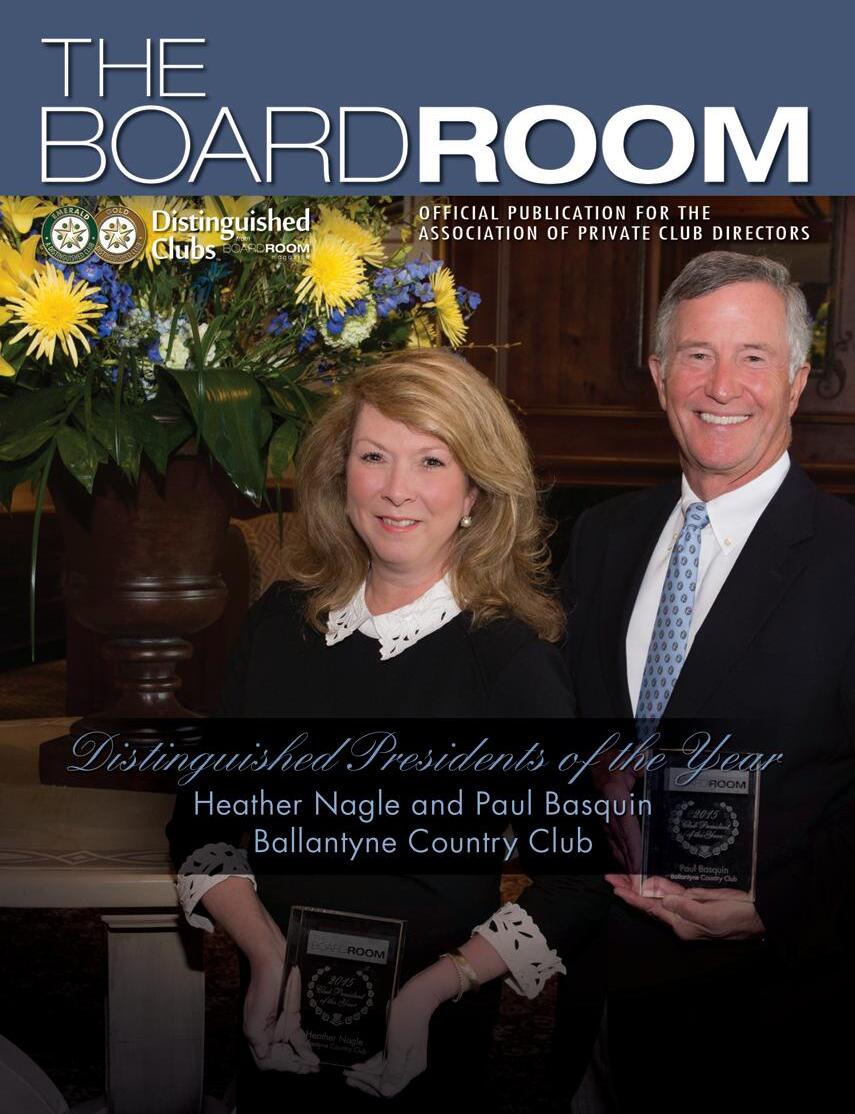







Ah, the ‘dog days of summer.’ But to be clear, for private clubs, it really has nothing to do with dogs.
The expression comes from the ancient Romans who referred to the hot, humid days of summer as ‘dog days.’ The Romans associated summer’s hottest days with the star Sirius…known as the ‘dog star’, because it’s the brightest star in the constellation Canis Major or Large Dog.
But for private clubs it’s a busy time…golf courses and tournaments, clubs and family events as everyone seeks a break from the daily grind.
And this issue, there’s something different as BoardRoom magazine honors its second set of Distinguished Private Club Presidents for 2015.
“It’s an anomaly. It’s an exceedingly different and enterprising situation and we’re delighted to honor two clubs, each with two presidents, as our Distinguished Presidents for 2015,” explained John Fornaro, BoardRoom magazine’s publisher and CEO.
BoardRoom this year is recognizing the presidents David Mackesey and Hank Salvo from the Diablo Country Club, near Danville, CA, and Heather Nagle and Paul Basquin from the Ballantyne Country Club in Charlotte, NC as BoardRoom’s Distinguished Private Club Presidents for 2015.
“These presidents from both these clubs have made exceptional contributions to their clubs and their members’ experiences, and it offered us an opportunity to do something different with our top private club presidents’ program,” Fornaro added.
“It certainly signifies another successful search for leaders who have contributed so much to their private clubs.
Boardroom recognized the accomplishments of Mackesey and Salvo in the cover story in our January/February issue
Now we honor presidents Nagle and Basquin in this issue. Jill Philmon, Ballantyne’s general manager (and also president of the Club Managers Association of America this year) nominated the duo.
BoardRoom also recognizes Jeff McFadden, general manager/COO of The Union League of Philadelphia, with its Award of Dedication…the second recipient named in 2015.
Earlier BoardRoom paid tribute to Gregg Patterson, who retired after many years as general manager of the Beach Club of Santa Monica and now heads his own consulting firm, Tribal Magic.
Erica Martin, communication and marketing director of The Union League of Philadelphia, in her article gives us insight as to what makes McFadden tick. He’s a busy, dedicated general manager and family man, and as Martin says, ”Jeff has hospitality in his DNA.” That, just might be a bit of an understatement!
Mike Phelps of Pipeline Consulting, in this issue, takes us a step further in social media and its use by private clubs. Mike calls it “The New Secret Sauce for Membership Marketing.”
“Important places on the internet like Google and Facebook have been quietly perfecting something known as lookalike audience targeting or match targeting.” Phelps writes that “it’s a modern solution to an increasingly difficult problem – how to get the attention of the right people. Lookalikes are simply a better way to reach new people who are more likely to be interested in your club because they’re similar to people you care about.”
Read Mike’s article, because he’s suggesting it’s a game changer for membership lead generation… and that’s something every private club can use.
And, if you really want to know the most important weapon in your arsenal of food and beverage sales, Steven Poe, master sommelier and beverage director at Big Canyon Country Club in Newport Beach, CA lays out his argument very clearly in this issue.
Interesting, to say the least! BR
Got a comment?
Drop us a note: dave@boardroommag.com
Publisher/CEO
John G. Fornaro
Editor/Co-Publisher
Dave White
Assoc. Editor/VP Creative/Co-Publisher
Heather Arias de Cordoba
APCD Executive Director
Bill Thomas
Editorial & Marketing Director
Dee Kaplan
Account Manager
Dina Alleluia-Carr
Contact Information www.BoardRoomMagazine.com www.apcd.com (949) 376-8889 or (949) 365-6966
Subscriptions and Website
Heather Arias de Cordoba www.BoardRoomMagazine.com (949) 365-6966
Featured Columnists
Rick Coyne
Henry DeLozier
John G. Fornaro
Chris Boettcher
Boyd Carr
Lisa Carroll
Michael Crandal
Rick Ladendorf
Lynne LaFond DeLuca
Todd Dettor
Dave Doherty
John Embree
Rhett Evans
Kristofer J. Fair
Bonnie J. Knutson

Co-Founder/CEO
John G. Fornaro
President Keith Jarrett
Chief Analyst Frank Gore
Chief Information Officer Jeff Briggs
Executive Director
Bill Thomas
Contact Information
www.DistinguishedClubs.com (949) 376-8889
Nancy M. Levenburg Gregg Patterson Bob Salmore Bill Scwartz Tom Wallace
Rob Harris
Larry Hirsh
David W. Lacey
Melissa Low
Craig D. Martin
Erica Martin
Tom McGraw
Peter Nanula
MacDonald Niven
Whitney Reid Pennell
Mike Phelps





Steven Poe
Ted Robinson
Steve Schendel
Nelson Scott
Eliza Selig
Contributing Writers Endorsements, Strategic Partners and Allied Associations
Mitchell Stump
Michelle Tanzer
Bruce R. Williams
Penelope Wong
BoardRoom





PUBLISHER’S PERSPECTIVE | 10

BY JOHN G. FORNARO
Yes, to err is human, but repetitious mistakes are a plague. Failure of fiduciary duties, little or no effective oversight of the club’s operation etc. But are these issues really ‘sacred cows’ because boards of directors are unwilling to tackle mistakes that are repeated so often?

BY BILL SCWARTZ
It’s the question every club manager and board member wants answered – “What should our food cost be?” The perfect food cost is the cost required to provide exactly the amount of food required to meet the legitimate need for it during the period in question.

BY RICK COYNE
Years ago, as a beer drinking college kid and under the constant stress of maintaining a grade point and bad eating habits, I developed a bad stomach ulcer. I simply reached for the Maalox. The doctor told me my diet and beer drinking would have to stop. So what’s that got to do with membership? Think about it!
18

BY TOM WALLACE
Is hospitality a field of work or a way of life? Ask my family and friends the most common phrase they’ve heard from me over my 25 year club management career, and they’ll tell you it’s “Hey, what did I miss”, as I slink in for the last few minutes of a basketball game, dance recital, birthday parties, etc.
PLIGHTS AND INSIGHTS | 14

BY NANCY M. LEVENBURG
“Try it, you’ll like it.” Are you old enough to recall this advertising slogan? Nowadays, “try it, you’ll like it” seems to be a common theme in marketing golf and private clubs … and there are innumerable variations that seem to work in bolstering memberships and revenues – in the short-term, at least.
GLOBAL

| 64
BY HENRY DELOZIER
What distinguishes the great clubs from the good clubs? Great clubs focus on the basics, starting with the principles, values and priorities that define them. Great clubs are characterized by dependable, trustworthy and resolute leadership. The trick is choosing and sustaining leaders who are trusted, respected and able to make difficult decisions. MEMBERSHIP MUSINGS | 66

BY BONNIE J. KNUTSON
The American writer, George William Curtis, was prophetic when he said: “It is not the ship so much as the skillful sailing that assures the prosperous voyage.” Little did he know that today, his comments would hit the club industry head on. Boards and managers alike have to remember that the club’s goal is thriving, not just s urviving.

BY BOB SALMORE
Leasing has long been a staple of club financing, particularly in relation to golf carts or golf course maintenance equipment and many of the leases have been classified as operating leases. On February 25, 2016, the Financial Accounting Standards Board issued Accounting Standards Update, its long-awaited final standard on the accounting for leases.

BY GREGG PATTERSON
My wife and I visited St. Petersburgh, Russia recently, wanting to “go deep” into the history. So we hired Helen for four days and quickly discovered that Helen had The Goods. Helen is the best because she is a TASS Master…a Teacher and a master; an Actor and a Master; a Speaker and a Master, and a Server and a Master. Helen had TASS…a TASS Master. Want to become a TASS Maste r like Helen?

Erica Martin
Craig D. Martin

Don’t Just Be Different Be Outstanding By
Kristofer J. Fair
Doctor
Rob Harris
SES Lighting
John Sibbald By
Michael Crandal
Chris Boettcher




Reid Pennell
Larry Hirsh
Stump

Yes, to err is human, but repetitious mistakes are a plague.
The failures and mistakes of non-profit boards have been well documented over the years… failure of fiduciary duties, little or no effective oversight of the club’s operation etc.
But are these issues really ‘sacred cows’ because boards of directors are unwilling to tackle mistakes that are repeated so often? What are the top mistakes private club board of directors make? Can we pin down the causes, and if so, what can a private club (and board) do to bring about change?

Michelle Tanzer suggests boards “attempt to make governance and operational changes and are not appreciating the risks or understanding the requirements under the club’s bylaws or applicable law. Many boards have lawyers but not lawyers experienced in the area of club law,” she explained. Tanzer also raises another crucial area for boards … “ the attempt to make changes to refund or redemption liability is sues.
Often these issues arise because private club boards of directors really don’t understand their roles in the club’s governance. In reality, good governance starts by building a board, a board with members who can work together for the betterment of the private club and its members and working toward the elimination of mistakes. So what are these ‘mistakes?’
“In my opinion, the biggest mistake private club boards make is not clearly defining their board’s members’ roles, along with the roles of committees and the general manager/chief executive,” intoned Dick Kopplin, principle with Kopplin Kuebler & Wallace, a private club industry search and consulting firm.
“When we see the ‘coloring outside the lines’, it is typically a result of not understanding who is responsible for operational issues versus governance issues in the club. This usually leads to ‘micromanagement’ of the general manager, which is a lose/lose proposition for all parties.
“The most crucial error that boards, and particularly the club president can make is to assume everyone know what their accountability lies regarding the ‘process’ that needs to happen in every club,” Kopplin added.
“The micromanagement curse typically happens because of a lack of education, especially for board members and new committee members.”
Michelle Tanzer, a Florida attorney specializing in residential, resort and club section at GrayRobinson, suggests boards “attempt to make governance and operational changes and are not appreciating the risks or understanding the requirements under the club’s bylaws or applicable law.
“Many boards have lawyers but not lawyers experienced in the area of club law,” she explained. Tanzer also raises another crucial area for boards … “the attempt to make changes to refund or redemption liability issues.
“Many clubs are facing a terrible dilemma. They are charging $X for a membership now but are obligated to repay the former member (under their bylaws or membership agreements) $X+Y. Thus, every time the clubs sells a membership there’s have a net loss,” she explained.


Years ago, as a beer drinking college kid and under the constant stress of maintaining a grade point and bad eating habits, I developed a bad stomach ulcer.
If you’ve ever had one or know someone that has, you know it’s very real pain – the kind that can double you over. So like any level headed college kid, I kept drinking the beer, kept stressing over grades, kept eating badly and when the symptoms came on, I simply reached for the Maalox.
Approximately a year later with symptoms occurring more frequently with even more pain, I finally gave in and went to the doctor to see what I needed to do to cure the problem. After some pretty invasive testing and learning the ulcers were worsening daily, the doctor told me my diet and beer drinking would have to stop. Essentially, he prescribed a cure, rather than a masking device.
So what’s that got to do with membership?
Think about it! Any club that has treated membership pain with short term programs, discounts and incentives, without a complete diagnostic of what’s causing the problem, has likely seen the same symptoms reoccur over and over, and it simply gets easier to reach for Maalox and use it more frequently. Hardly a roadmap to sustainability.
Fundamentally, there is commonality in the broader issues effecting private clubs. But there are also site specific market issues that require knowledge and understanding of the club’s core issues that are preventing membership success, without which, Maalox starts looking pretty good to cure the pain.
Clubs often misdiagnose their membership situation, thinking something external will change and make everything perfect again. That’s pure and simple the “drink the Maalox mentality.” Change is an ever cycling reality and without meeting the needs and relevancies of members and marketplace, price won’t have anything to do with the decision to join or stay.
Serving and satisfying our existing members is deeply ingrained in the culture of managing a private club, and for all intents and purposes, we are
doing a pretty good job in most areas. But, satisfying our current members, in terms of branding your club for future growth, must include relevant programming and activities that have appeal to women, families – the next generation of member.
The non-member world is judging your attractiveness and relevance to their lifestyle by everything that you do internally. Part of a prescription to cure, then, is to evolve your focus on what the new membership market wants and needs, simultaneously addressing the needs of your existing members.
Consumer habits continuously evolve. Members and potential members are constantly bombarded with messaging on competitive activities outside of the club. Static amenity and activity planning, without recognizing these crucial changes in member’s lifestyles, can’t be successfully managed with Maalox.
Women see the world differently than men. Families have needs that empty nesters don’t, and the availability of leisure time challenges the entire population. The prescription for cure is creating greater relevance to these readily apparent market realities.
Throwing random programs at the problem is drinking the Maalox. Understanding and addressing change as the new reality, doing the appropriate due diligence to understand the exact nature of your market, and then offering a more encompassing array of lifestyle programs and amenities is the sustainable cure. That’s what it takes in today’s competitive market to get new members, keep them, get them using the club more often and telling their friends. Models built on pricing alone are recipes for disaster and ultimately destroy the value and integrity of the club, and to some degree, the entire industry.
It’s time to stop drinking the Maalox and get back on the road to sustainable membership health! It’s really not that hard to change the process... BR
Rick Coyne is CEO, Professional Club Marketing Association. He can be reached via email: rcoyne@clubmark.com


“Try it, you’ll like it.” Are you old enough to recall this advertising slogan?
It was the advice that a well-meaning waiter gave a customer who was unfortunately afflicted with gas and acid indigestion after eating a meal that didn’t agree with him. Needing urgent relief, the customer’s server offered him an AlkaSeltzer. “Try it, you’ll like it. Plop, plop, fizz, fizz… oh, what a relief it is!”
Nowadays, “try it, you’ll like it” seems to be a common theme in marketing golf and private clubs … and there are innumerable variations that seem to work in bolstering memberships and revenues – in the short-term, at least.
Offering a price discount with a new membership is one of the most frequently used tactics –and it’s also one of the easiest to implement. It’s the old application of the downward-sloping demand curve … if you reduce the price, people will buy more. And why is it so easy to implement? Because you don’t have to change anything else in your marketing strategy… all else remains the same.
For example, your club might offer discounted membership fees to new residents in the area, to part-time residents in the area, or to younger people (“junior members,” under 39 years of age) in order to attract them to join.
What might the discount include?
• No – or a reduced – initiation fee!
• No food and beverage minimum, and no automatic gratuity
• Delayed billing
• No monthly capital funds, supplemental dues, or special assessment fees
In short, the only requirement would be a commitment from a new member, and a valid bank account or credit card.
On the other hand, in recent years, sale prices and membership discounting has become more common, which can be confusing to the public and erodes the “prestige value” of the club (and brand loyalty). As a result, marketers often advise that price discounting should be used carefully…
“a marketing manager who constantly uses temporary sales to adjust the price level probably has not done a good job setting the normal price.”
Another commonly used tactic is to entice new members by getting something extra. Marketers term this a sales promotion, which typically lasts for only a limited time period. So, the free offer is designed to prompt short-term action. As examples, a new member who signs on the dotted line before May 15 might get:
• Free tickets to an upcoming event
• A credit in the pro shop.
• Free 18-hole guest passes (cart required, of course).
• Free dinner.
One country club in Southern California mailed 2,000 invitations to prequalified individuals for a free dinner at the club. About 125 attended and eight memberships were sold. While that might not sound like a lot, how does it compare to the price of membership? If the mail campaign cost $4,000 and the dinner was $6,000 (approx. $50/attendee), the breakeven point might be only one or two new members… if that!
Members of the local business community may be a primary target market for your club, and one of the most effective ways for you to reach out to them is by inviting them to host a business meeting or event at the club. This enables them to tour the facilities and experience all the club’s amenities directly and in person. Then, the club might follow up by offering a discounted membership to that particular organization or association.
In other words, “try it, you’ll like it!” BR
Nancy Levenburg, Ph.D., is a professor in the Seidman College of Business at Grand Valley State University in Grand Rapids, Michigan. She is the President of Edgewater Consulting, and is a member of Spring Lake Country Club in Spring Lake, Michigan. For more information, contact her at: levenbun@gvsu.edu or (616) 331-7475.





















These top executives have taken their clubs to a higher level by implementing a better approach for managing club food and beverage departments. Building on a foundation of best practices, checks and balances, and integrated business flows, they incorporated leading-edge food and beverage automation and reduced labor by tying all their systems together.
The controls, disciplines and reports produced by this approach make it possible to run food and beverage departments at peak efficiency, substantially reducing clerical labor and food costs. Innovation. A better way to do business
Just what you would expect from leaders at this level.
Find out more. Call us at 800-553-2438.
Or just ask them!
http://www.foodtrak.com



It’s the question every club manager and board member wants answered – “What should our food cost be?”
Sometimes called the perfect, theoretical or ideal food cost, the definition is more straightforward than the achievement. The perfect food cost is the cost required to provide exactly the amount of food required to meet the legitimate need for it during the period in question.
This number may be significantly different from the budgeted food cost number. Even if the food cost is equal to the budgeted cost, it could be as much as 5-10 points higher than the perfect food cost. This variance between actual and perfect food cost is simply defined as the cost of food used in excess of what was actually needed. It comes from a variety of sources, including waste, theft, spoilage, over-portioning and reduced yield. To the club with $1 million in F&B revenue, this variance represents between $50-100 thousand per year!
Unfortunately, the perfect food cost is nearly impossible to calculate for all but the simplest foodservice operations. The calculation is fairly straightforward. Simply take the number sold of each menu item, multiply the quantity of each ingredient required by the menu item’s recipe by that amount, adjust for the yield of each ingredient, extend the accumulated quantity adjusted for yield by the cost of the ingredient and then add up all the costs for all the ingredients required by the sales of all of the menu items. This may be tough manually, but can be performed easily using appropriate software.
The difficulty relates to the recipes themselves. Menu items offer choices between sides, salad dressings, and other components of a dish, and guests have access to complimentary table items like bread baskets and condiments. Every ingredient of every choice and complimentary item must be considered in proper proportion, requiring averaging and popularity studies. The actual recipes required to calculate perfect costs (and correct menu item costs) look
nothing like cooking recipes. A simple burger plate may have only 10 line items in the cooking recipe, but over 100 line items in a costing recipe. Even though high-end F&B management software can do the calculations, very few operators have the time or experience to build these types of recipes.
So how can a club reduce variance and approach this perfect food cost if it can’t properly calculate it? The answer lies in what I refer to as the Path to Perfection. While it may not be possible to arrive at the finish line, every step along the path helps reduce the variance. It is also important to take these steps in the proper order, which makes the path analogy even more appropriate.
In order to reduce the variance, we need to attack its components. As mentioned earlier, waste, theft, spoilage, over-portioning and reduced yield are the primary causes of variance. Each step along the path is designed to address one or more of these components.
The first section of the path deals with procurement and everything related to it. Next comes inventory management, followed by culinary processes, key item tracking and finally report analysis and action steps.
These steps do not require changes to the menu or pricing. They have nothing to do with what you pay your purveyors for food, and they do not require the kind of recipe construction described above. But done properly and in the correct order, they can reduce variances by 80 percent, resulting in savings of up to $80,000 per million in F&B revenue.
Stay tuned
Up next – the procurement section of the Path to a Perfection. BR
Bill Schwartz is the founder and CEO of System Concepts, Inc. (SCI). Based in Scottsdale Arizona, SCI is a food and beverage procurement and inventory management consulting firm and the developer of the FOOD-TRAK System, which is widely used in club operations around the country. Bill can be reached at (480) 951-8011 or bills@foodtrak.com.


Many of you who know me are familiar with my sign off at the end of my emails – “Hospitality is defined as kindness, welcoming or generous. So I ask, is hospitality a field of work or a way of life?”
That statement defines my belief and me in both good and bad ways.
Ask my family and friends the most common phrase they’ve heard from me over my 25 year club management career, and they’ll tell you it’s “Hey, what did I miss”, as I slink in for the last few minutes of a basketball game, dance recital, birthday parties, etc.
I love the hospitality industry, and the club business is by far the greatest segment! The opportunity to lead a team that shares your passion for taking care of people, the ability to run a multi-million dollar business while being surrounded by some of the most wonderful, interesting and prominent people in your community, and the operation of breathtaking facilities and life enhancing amenities is unlike any other.
But there are downsides. Not unlike other hospitality fields (restaurants, resorts and hotels), there are long hours, late nights, weekends, holidays, missed vacations, not to mention the need to move often throughout your career, uprooting your family and leaving friends. These are just a few of the sacrifices hospitality professionals make.
I know all of my former teammates are going to laugh at some parts of this article about work/life balance as I certainly led from an old school perspective. “Work only half a day… it makes no difference which half….the first 12 hours or the last 12!” Luckily I learned and grew to understand work/life balance or what we used to call “visibility versus burnout” before it was too late.
More and more leaders and future leaders are finding it less and less acceptable to sacrifice a work and life balance even though they feel passionately about their careers.
The “Hey, did what I miss” for GMs and boards can’t be, and shouldn’t be, the environment newer generations in the workforce want for their lives or their careers. Progressive lead-
ers understand that, if they manage their people well, the club can function properly without their constant presence.
Thoughtful leaders know that in order to function at an optimal level they should emulate and encourage a work/life balance. This balance centers around general managers hiring the best key department heads and partnering with them.
Is this easier said than done? Unless you’ve figured out a way to clone people to develop excellence, what is needed now in our work places is for GMs to set expectations of the reality of the hospitality business for their managers and key department heads.
We must set the expectations for our high standards of operation with a plan for getting there that includes a work/life balance. Making sure you have true thought partners as key department heads and arming them with the tools they need to develop their team to carry out excellence is the paradigm for success, even in their absence.
In order to attract and retain the best and the brightest, we must stress the importance of a work/life balance and be committed to it. A work/life balance allows you to be fully present in any setting and being fully present is what progressive leaders now embrace.
GMs must also set expectations for the board, starting with the board orientation. (Your club doesn’t provide new board members with an orientation? Start now.)
If they want to have the best and brightest as part of their club, the best and the brightest can’t/won’t work 70-hours a week. So budgets will change and so, too, will the number of managers on the team. Great clubs are not interested in grinding their leadership team down, but we have also all heard the rumblings about how many “more managers we have now” than in the past, as if that’s a bad thing.
While a lot of successful managers and board members at successful clubs are reading this, they’re thinking, is this really a problem? Yes!




COVER STORY / BY DAVE WHITE
SOMETIMES THE ORDINARY MAKES THE NEWS (DOG BITES MAN) …SOMETIMES IT’S THE EXTRAORDINARY (MAN BITES DOG) …THE ANOMALY. AND THAT’S THE STORY WITH BOARDROOM MAGAZINE’S PRIVATE CLUB PRESIDENTS OF THE YEAR FOR 2015.
For the first time since BoardRoom magazine established this program of recognizing the private club industry’s top private club presidents eight years ago, there are two double entry recipients selected as BoardRoom’s Distinguished Presidents.
“It’s an anomaly. It’s an exceedingly different and enterprising situation and we’re delighted to honor two clubs, each with two presidents, as our Distinguished Presidents for 2015,” explained John Fornaro, BoardRoom magazine’s publisher and CEO.
“In reviewing the more than 400 applications from clubs in several countries, we felt we had to recognize the presidents David Mackesey and Hank Salvo from the Diablo Country Clubs, near Danville, CA, and Heather Nagle and Paul Basquin from the Ballantyne Country Club in Charlotte, NC as our BoardRoom Distinguished Private Club Presidents for 2015
“These presidents from both these clubs have made exceptional contributions to their clubs and their members’ experiences, and it offered us an opportunity to do something different with our top private club presidents’ program,” Fornaro added.
“It certainly signifies another successful search for leaders who have contributed so much to their private clubs.”
The accomplishments of Mackesey and Salvo at Diablo Country Club were featured in a BoardRoom cover story in our January/February issue. This issue we honor presidents Nagle and Basquin of Ballantyne Country Club.
“I’ve had the good fortune of working with Ballantyne Country Club for many years now, and can certainly confirm that much of the credit for the club’s recent success goes to their presidents Heather Nagle and Paul Basquin,” explained Kurt Kuebler of Kopplin Kuebler & Wallace, the private club consulting firm that supports Boardroom in its annual search for the industry’s top presidents.
SEE COVER STORY |22


Ballantyne Country Club faced a most challenging issue …making the change from being a developer-owned club, to an equity club operated by a management company, to a club that made the decision to govern itself.
General manager Jill Philmon (also president of the Club Managers Association of American this year) joined the club in 2010 with the objective of completing a new master plan.
“The most challenging issue with a developer club is ‘buy in’ from the membership. With developer clubs, the member mentality is more of a resort/guest feel and less of that as an owner,” explained Philmon. “It takes a lot of education and information sharing to help
“To be honest, it’s been one of the most effective teams I’ve ever worked with. Had either of them had an ego, a self-driven agenda, or just not been willing to work as a team,
it could have been disastrous for the club. They were so effective. We completed the project on time and on budget, and many of the members that voted against the plan have stated that they were wrong and are thrilled with the results. Our members trusted Heather and Paul and their leadership completely.”
Jill
Philmon, GM/COO Ballantyne Country Club
members realize that investing in their club, especially if it’s a neighborhood club, members investing in themselves and their home value.
Also during a transition, there is a lot of miscommunication and not always a feeling of transparency between the membership and the board, especially when assessments are involved.” So at one point there was a lot of contention and mistrust, not an unlikely situation.
Fast forward to late 2013. The club was in the middle of many changes including efforts to get agreement on the club’s new strategic master plan. Heather Nagle assumed the presidency with the sole purpose of moving this plan along.
“President Nagle was extremely effective in open communication, and transparent with the membership in all areas of the plan including the club’s finances of the club. Her ideas to communicate with the membership were new and refreshing, creating a safe and trusting environment for the membership,” Philmon expressed.
Eighty-two percent of the members approved the plan…”an incredible accomplishment for President Nagle, whose term ended in February 2015. We came from a membership that didn’t feel the need to buy in, to a majority that feels great pride in the club.”
Enter President Paul Basquin…an insightful leader who understood how effective his predecessor has been in affecting change. He asked Nagle to stay on in an advisory position, to the great benefit of Ballantyne Country Club.
“To be honest, it’s been one of the most effective teams I’ve ever worked with. Had either of them had an ego, a self-driven agenda, or just not been willing to work as a team, it could have been disastrous for the club,” Philmon confided.
“They were so effective. We completed the project on time and on budget, and many of the members that voted against the plan have stated that they were wrong and are thrilled with the results. Our members trusted Heather and Paul and their leadership completely.”
The result? Ballantyne Country with its maintenance and capital improvement plan has during the past two years completed 99 percent of its projects, on time and on, budget…changes made with an extremely high level of membership satisfaction and use.
“Not a single member has come up to me since completing work on the golf course and other upgrades to complain about having to invest in these improvements. That’s the true testament as to how well this process has been handled,” commented member Darren Gale.
“The improvements we’ve made had an immediate positive impact on the members. You could see the uplifted spirits and pride everyone has about their club. There’s a spring in their step and a smile on their faces as they step into the club,” added club member Clark Jackson.
“Our course is in premier shape and members are able to play daily on a tournament conditioned course,” Philmon added. “And as you can see by Mr. Jackson’s comments, our members are extremely proud of their club and appreciate the added amenities.”
Does this team concept of two presidents make any sense? To Kurt Kuebler yes, it does. “Crossover and duplicity of effort and continuity of focus sounds like a great thing to happen in a club,” he expounded.
“He’s right and I’m delighted that the club, our members and and me, as the club’s general manager, have benefited from the Nagle/Basquin team,” Philmon explained.
Presidents Nagle and Basquin have supported GM Jill Philmon strongly. “They never get involved in operations, or as we call it, the “peas and carrots”, but more importantly they support my involvement in CMAA, and they support the staff and their education programs.
“It’s not just CMAA they support but all of the educational allied associations. We have a large education budget but they don’t see that as an expense. They see the value in the education and consider it an asset. They also very much believe in educating themselves.
“Each year the board has a weekend retreat, out of town, to work on governance issues, goal setting and evaluating the job they do as a board. My staff and I are successful because we have a board that understands their role and allows us to do ours,” Philmon opined.
“They’ve had great boards and board members, but Heather so clearly bought into the strategic focus that the board needed to take, and followed so adeptly by Paul,” added Kuebler. It’s a pleasure to see how well things can go when there is exceptional collaboration and an outstanding ‘hand off’ of the baton from one term to the next.
“There are way too many clubs today where that doesn’t happen, resulting in a waste of time, effort and money. When it goes this well and this smoothly, it’s a model to consider!" Kuebler offered. BR
Private club board presidents play a huge role in the professional operations of their club as volunteers working diligently with their board of directors and general managers, striving for well informed, but not emotional decisions.
BoardRoom magazine’s outstanding private club presidents for 2015 exemplify the focus on the leadership responsibilities, the accountability and the management of the board, while providing a healthy respect for the club’s macromanagement.
They understand the importance of working, effectively and efficiently, with their volunteer boards and the dedication that’s required from everyone with whom they work.
They practice what they preach – outstanding leadership to maintain best
practices and an extraordinary member experience for their members clubs.
These points are exemplified by the selection of 2015’s Distinguished Club Presidents, David Mackesey and Hank Salvo of Diablo Country Club in Danville, CA, and Heather Nagle and Paul Basquin, a presidential duo at Ballantyne Country Clubs in Charlotte, NC.
Systems along do not insure a good board. Key elements include commitment, competence, diversity, collective decision making, openness, transparency, effective communication with management and the membership, fiscal responsibility, development and establishment of the club’s mission, vision and policy direction, especially through establishment of a strategic plan.
Successful board presidents draw upon the expertise of other board members, the club’s institutional memory and stewardship of the club’s resources. As well, board presidents provide new board members and future presidents with information they need to perform effectively as board members.
Nominations for top board presidents for 2016 are open. Information can be found on BoardRoom website (boardroommagazine.com) or on page 49. Deadline for entries is Friday, November 17, 2016.
For further information, contact John Fornaro at (949)n376-8889, ext. 2, or via email: johnf@apcd.com
“When Heather (Nagle) and I received BoardRoom’s Distinguished Club Presidents for 2015 award, after absorbing the shock, it’s really like accepting the MVP award in a team sport. Without the rest of the board, our committees, and Jill (GM Jill Philmon) and her staff, we would not have been in a position to be selected,” enthused Ballantyne Country Club’s President Paul Basquin.
Basquin and Heather Nagle, who shared the presidential duties in 2015, are one of two sets of presidents Boardroom magazine has recognized as Distinguished Club Presidents for 2015.
Both Basquin and Nagle credit the club’s solid committee structure as a key element in developing a successful $7.4 million maintenance and capital improvement plan approved by 82 percent of the club’s members, and which has been completed with 99 percent of the massive multi-facility and golf course plan delivered on time and within budget during 2015.
“Our committee structure is the foundation of Ballantyne’s club governance. Our members are engaged and active, thoughtful and caring, and conscientious about their roles on our committees. They make the work of the Board relatively painless,” added President Basquin.
In developing, approving, and executing the improvement plan, almost 100 club members were involved through various committees and task forces.
“This was a plan for the members, by the members,” stressed President Nagle. “The board presented our first facility master plan in the fall of 2013… a culmination of five years of surveys, focus groups, planning meetings, etc.
“As many clubs unfortunately experience, it was not approved. In fact, we experienced some of our most passionate town hall meetings ever. The membership spoke and clearly the plan and cost did not resonate. The morale of the membership and staff was at an alltime low and were frustrated.”
This was followed by another survey. “We needed to identify specifically what the membership was looking for and how much members were willing to contribute,” Nagle added. That turned out to be 1) critical maintenance needs, a list that was expanding, 2) creating a reserve fund and 3) making reasonable improvements, a direct reflection of the club’s latest survey.
“Implementation required a huge time commitment, hard work, patience and a positive outlook by everyone,” said Nagle. In the middle of all this, the transition in roles happened, as Basquin succeeded Nagle.
“We had a great understanding of what our roles were during this time, because it was incredibly important for us to work together as a team. Paul has become an outstanding board president and great friend!” expressed Nagle.
Other changes have followed. “At the start of this year, we implemented a formal committee orientation… where all serving and new committee members are required to attend a session where we review industry trends, discuss the relative roles and responsibilities of the board and the committees, present the board’s key objectives for the upcoming year, and then break into groups to tour back of the house areas of the club that members don’t normally see,” Basquin explained.
“The value of this orientation is exemplified by the statement of a committee member, after touring the superintendent’s maintenance area, ‘I had no idea!’
“That was exactly the intention. This formal committee orientation will be an on-going annual event at Ballantyne Country Club,” Basquin alluded.
President Nagle was also a member of the search committee that hired Jill Philmon as the club’s general manager and COO. “We hired the CMAA’s very own president, and we’re extremely proud of her and her position with CMAA.
“We equally support her endeavor to encourage all of our employees to be the best that they can be through education. I believe an employee's accomplishments to be an admirable reflection of any great manager. Jill and her staff have much to be proud of!
“As a new member-owned club, our committees were still developing when Jill came on board. Her support and knowledge has enabled the board to develop further our club governance and create a more effective and efficient committee structure. A system, which I believe to be one of our club's greatest strengths,” Nagle expressed.
“With the changes we have made over the last 18 months we, as a club, seem to have a renewed spirit and optimism for the future,” President Basquin added. “That, combined with
the professionalism of Jill and her staff, and the support of our committees and the other board members, really makes my role as President pretty fun…”
Ballantyne Country Club celebrates its 20th anniversary this year and “we’ve come a long way and wouldn’t be where we are without all our former board and committee members,” commented Nagle.
“We have also had many wonderful opportunities to work with industry consultants over the last 6 years. All are members of CMAA – an organization that has been incredibly impactful to our club and helped shape where we are headed in the future.
“I also congratulate BoardRoom magazine on its 20th anniversary…your motto is one that every club board should remember – ‘Replace emotion with fact.’” BR





JOHN EMBREE
The USPTA historically has taken great pride in being considered cutting edge when it comes to technology.
Now in 2016, USPTA is raising the bar with a variety of technology initiatives at the upcoming USPTA World Conference in Indian Wells, CA, Sept. 25-29.
When you send your tennis director and teaching professionals to the world conference, not only will they have the opportunity to learn from leaders in the tennis industry, but they will also have up-tothe-second information, greater access to education, and the ability to view offers from exhibitors right from their mobile devices and computers. These technologies will help make the conference experience more convenient and efficient than ever before, allowing attendees to benefit even more from sessions covering topics such as court maintenance, retail and pro shop management, leadership and, of course, coaching.

With the world conference app, attendees will be able to create a custom schedule for the events and seminars they attend, find out more about speakers and exhibitors, give instant survey feedback after sessions, and much more.
Not only can they receive notifications for reminders and room changes, they also will be able to receive individual notifications tailored to their experience. Interactive maps make navigating the conference easy and intuitive, and visitors can find out how to get around Indian Wells, learn the layout of the hotel, or explore the buying show floor plan. Networking is easy with the app. Attendees can meet up with old colleagues or manage new connections with the ability to message other attendees right through the app.
When coming to the world conference, pros will be able to check in quickly and receive the information they need because of the new self-check-in option. Simply by walking up to one of the tablet stations and inputting personal information, ID badges will automatically be printed out and all the conference information will be distributed on the spot!
The virtual event bag is a “green” way for attendees to take advantage of offerings from exhibitors, enhancing the buying show experience. Similar to online shopping, attendees will add items to their “bag” and either redeem the exhibitor’s offer at the show or save for later. The bag also allows vendors to reach an even greater audience than the buying show. The virtual event bag will open to the public Sept. 19 and be available for 30 days after the show for tennis professionals and coaches to take advantage of information, discounts and other offers.
If your staff cannot attend the world conference but would like to take advantage of the expertise of the speakers, have them sign up for live streaming. Multiple general sessions will be streamed via YouTube to those professionals and coaches who cannot attend, allowing them to earn education credits while at home or taking a break at their club or facility.
The USPTA World Conference is the premier event in the tennis industry because of its ability to bring together the top industry professionals and leading experts on all things tennis. Using social media to meet and connect with other attendees or speakers after a great session or a meeting is a fantastic way to stay in touch. And the sharing of ideas, even after the conference is over, is one of the many benefits of attending. Go to uspta.com/conference to learn more and get information about a special discount for club professionals. BR
John Embree is CEO at the United States Professional Tennis Association and can be reached via email: john.embree@uspta.org or 713-978-7782, ext. 117.

BY ErICA MArTIn

Jeffrey P. McFadden CCM CCE ECM, is one of the most dynamic, savvy and likeable guys you would ever hope to know.
He is innately kind, exceedingly smart, witty, sarcastic, fun and visionary. He is a leader and an empowerer. He is a devoted father and husband and a friend to many. He is a one of a kind, powerhouse of a guy. It’s no wonder he is so revered.
Jeff is a worker. His success can be attributed to hard work and learning the basics before honing his skills and becoming the leader in the club world.
Jeff grew up on the Jersey Shore where he started in the hospitality industry at a young age. He worked his way up the food and beverage ladder at the famous Essex and Sussex Hotel, the Shoreham Hotel and the Warren Hotel. His first club position came in the form of a summer internship at the Mantoloking Yacht Club where he was the club manager.
He remembers this position fondly. “I created a lobster night that worked incredibly well. We made money and the members were thrilled. They thanked me and they truly meant their appreciation. In that moment, I felt like the hospitality world was for me. I enjoyed helping the members and seeing their happiness. I never looked back,” Jeff related.
In 1990 he graduated with honors from Cornell’s School of Hotel Management and accepted the position of food and beverage director at the Cosmos Club in Washington D.C. Jeff produced the first food and beverage surplus in the club’s 125-year history.

At 27 years of age Jeff took on his next challenge and headed west to the University Club of Denver, becoming one of the youngest general managers in the country. In 1998, Jeff became the general manager/COO of The Union League of Philadelphia.
In his 18-year tenure, Jeff has led the Union League and many boards and presidents to unimaginable success.
“The Union League of Philadelphia was founded in 1862 to support the principles of Abraham Lincoln and help preserve the Union. It was conceived in a time of crisis. In 1998, the League hired Jeff, who was just 30 years old, as its general manager,” explained past president Jack Zook.
“This conservative social club with its imposing edifice on Broad Street was facing a different crisis. With a rapidly declining membership and a clubhouse that was literally and figuratively sinking into its own foundation, the League was going out of business. It is my personal opinion, and the opinion of all of the past League Presidents, that without the advent of Jeff the doors would be shuttered today,” Zook added.
“Jeff is a visionary who thrives on challenges and expansion. He leads by example and is constantly evaluating how to improve and expand the League and its amenities even with our standing as the number one city club in the country. If we look at what has been accomplished since Jeff took the helm, it is staggering given the deep deficit and deferred maintenance issues he inherited.
“Since 2001, the League has spent over $82 million in capital expenditures to refurbish every part of the 250,000 square foot

clubhouse. We acquired a 300 car garage adjacent to our clubhouse, built the best fine dining room in the city, acquired an 80 seat restaurant in Stone Harbor nJ, and two years ago, purchased a historic golf club in Philadelphia, which provides us with the ‘town and country’ club that Jeff had always envisioned for the League,” said Zook.
Jeff always goes above and beyond. He sees the bigger picture. Simple gestures often make the biggest impact and Jeff is notorious for “making it happen.”
recently a member mentioned in casual conversation that he liked a particular wine but was having trouble getting it because it wasn’t available in Pennsylvania. In typical Jeff fashion, he drove to new Jersey (where the selection is greater) and purchased a case of the wine and delivered it to the member at his home, completely as a surprise.
In another instance during the chaotic moments before a very large-scale member event, Jeff received information that a member who would be attending had serious dietary restrictions of which the staff was unaware. She could only drink carrot juice and would be at the event in just an hour. What did Jeff do? He got carrot juice. He made it happen. He always makes it happen.
Jeff leads his 500-person team of employees to be the best in their positions. He cultivates a professional, but friendly environment and engages employees in every position. He treats everyone the same and he fosters relationships.
Jeff believes in promoting from within and has created a second family among employees. Jeff uses every interaction as an opportunity to teach, provide guidance and create experiences. He instills a clear message in every employee: The answer is always yes. now tell me the question.
“Jeff has hospitality in his DnA. He brings a dynamic energy to everything he does,” espoused vice president of finance Jim Dunigan
“He has an ability to spot trends in their infancy, which allows us to breathe innovation into our thinking. He is a great judge of people and their talents and they blossom under his guidance. His vision and leadership has helped the Union League build on their agenda of success. Jeff’s view is ‘you are either green and growing or ripe and rotting’ and he lives it. We would not be where we are without him,” Dunigan added.
Jeff is actively involved with Club Manager Association of America and the national Club Association. He achieved his certificat ion in club management from CMAA in 2001, Honor Society in 2008 then certified as a Chief Executive in 2009. Additionally, Jeff earned is ECM in 2010.
Locally, he co-founded the Philadelphia Club Foundation to support student and manager club edu-
cation in the Delaware Valley. With the help of chapter members, the Philadelphia Club Foundation now supports 100 percent of local professional management education as well as three $10,000 student club management annual scholarships.
In 2004, the Philadelphia and Vicinity Chapter honored Jeff as Club Manager of the Year by. In 2005 and 2009, Jeff was awarded the national Club Association’s Council Member of the Year and in 2012 the national Excellence in Club Management Award sponsored by Club and resort Business and the McMahon group.
Jeff currently serves on many boards, including; Angel Flight East, Avenue of the Arts, Inc., Cradle of Liberty Council – Boy Scouts of America, greater Philadelphia Hotel Association, gulph Creek Hotels, is chair of the national Club Association Foundation, the Pennsylvania Aero Club, roman Catholic High School, Wings Field and Widener University School of Hospitality.
Though his professional endeavors are demanding, Jeff finds a terrific balance and makes quality time with his family. Jeff and his wife of 16 years, Julia, have two beautiful children, Jack and Madeline. Jeff is currently coaching Jack’s baseball team, the Angels.

In a recent school assignment, in perfect cursive, 11 year old Jack said, “My dad coaches baseball and that is my favorite reason [for playing}.” Jeff keeps this note in his desk drawer and looked at it with a smile he couldn’t hide. He’s a proud dad and for good reason.
In his “free time” Jeff is also a private instrument rated pilot and an avid golfer. An all around fantastic guy, Jeff McFadden is most deserving of Boardroom Magazine’s Award of Dedication. BR
Erica Martin is communications and marketing director, The Union League of Philadelphia.

A “one-in-a-thousand-year event.” That’s how the The National Weather Service referred to the six to eight hours of heavy rain that pounded West Virginia on June 23rd.
The downpour created devastating floods that ravaged most of West Virginia, resulting in more than 20 deaths and thousands of people losing their homes and possessions.
White Sulphur Springs, population of 2,500 located near the famous Greenbrier Resort, happened to be one of the hardest hit areas and it’s also the hometown of me and Kevin Given, managing partner/general manager, Quail Valley Golf and River Club.
We had to help!
The next day an email was sent to clubs throughout Florida requesting donations for bottled water, clothing, shoes, diapers, toilet paper, medical supplies, hydrogen peroxide, and bedding.






More than 30 members of the Club Managers Association of America (CMAA), Florida Chapter, and their employees immediately responded by contributing the requested items along with more than $75,000 in donations for the Greenbrier County Relief Efforts fund.
Byron Russell, CEO/chairman of CBI, has been partnering with our Greenbrier County Relief Efforts to help collect pledges and contributions to help fund the distribution of necessary and critical supplies to those flood victims in White Sulphur Springs. A portion of the financial contributions allocated to Cheney Brothers Inc. (CBI) was used to purchase supplies, which had a very positive and immediate direct impact on helping the flood victims.
The first delivery of supplies arrived three days after the flood at the White Sulphur Springs Emmanuel Methodist Church – a tractor trailer loaded with over 29,000 pounds of bottled water, brooms, cleaning supplies, paper goods and food. The cost? Roughly $29,000, exclusive of the transportation costs.
Donated supplies collected from employees of Boca West, St. Andrews and the Boca Community Church in Boca Raton arrived a few days later on a second tractor trailer.
Additional donations on the truck included new and used clothes, baby supplies, medical and hygiene supplies provided from many friends of friends. Other items included 50 cases of bottled water donated from US Foods and a generous donation from Show Turf (John Deere) with three new generators, three water pumps and 15 new shovels along with








Turfgrass fertilization is a primary component of golf course management that directly affects turfgrass health and playability, the maintenance budget, and environmental quality.
A golf course nutrient management program that promotes optimal turfgrass health while safeguarding environmental quality and frugal use of budget dollars is efficient.
Protection of both groundwater and surface water resources is a primary environmental goal within golf course management. Strategies to reduce nutrient leaching and runoff are considered best management practices and include the use of buffer strips of unmaintained and/or higher cut vegetation adjacent to waterways, soil amendments that reduce leaching potential, avoidance of overloading the turf system with nutrients, working closely with climate and weather data, appropriate irrigation practices, soil testing, accurate application methods and proper product selection. Grigg Brothers® Proven Foliar™ fertilizers have been tested for foliar nutrient uptake at four U.S. universities on three different turfgrass species (creeping bentgrass, annual bluegrass, hybrid bermudagrass), and research data clearly indicate that turfgrass plants can absorb greater than 80% of applied nutrient through the leaves when the fertilizer is properly formulated and the nutrients properly chelated. (see below)

Nutrient runoff and the subsequent eutrophication of surface water has led to the ban of phosphorous fertilization of turf in many communities across the U.S. and Canada * Researchers at Auburn University have documented that leaching of phosphorous may occur in sand root zone putting greens † .
Phosphorous is a main component of ATP (adenosine triphosphate), an energy compound used for many metabolic processes within plants, and is thus critical to plant survival. While soil tests may indicate ample phosphorous availability in some locations, phosphorous deficiency can occur in others, particularly sand root zone putting greens with calcareous pH and/or cool soil temperatures throughout much of the growing season ‡. Utilizing a chelated phosphorous source fertilizer in light and frequent application will minimize risk of phosphorous loss to the environment, and maximum nutrient use efficiency will be lead to optimal agronomic conditions. Research with Grigg Brothers Proven Foliar fertilizers indicates greater than 85% phosphorous uptake by the turfgrass plant §. By following recommended rates for Grigg Brothers Proven Foliar fertilizers, very little phosphorous would be available for loss to the environment, and most not immediately absorbed by the turfgrass leaf tissue would be taken up by the plant roots, fixed in the soil or used by microorganisms.
Only Grigg Brothers has the documented nutrient uptake data to demonstrate the efficiency of advanced fertilizer formulation technology and its related benefit to the environment. Using the most efficient fertilizer available enables turf managers to apply less total nutrient per unit area across the growing season to achieve agro-
nomic objectives while safeguarding environmental quality by minimizing the potential for nutrient loss.
Efficient golf course fertilization strategies should involve the use of products with proven agronomic results, the highest level of uptake efficiency, and reduced risk to the environment. Grigg Brothers Proven Foliar fertilizers utilize naturally occurring, plant-derived organic chelating and complexing agents that provide nutrients to plants in the proper ionic form. The documented uptake efficiency optimizes agronomic programming and minimizes the risk of nutrient loss to the environment. University research has shown that Grigg Brothers Nutritional IPM™ fertility plans and Proven Foliar™ products can help reduce pesticide inputs and maintain quality turf conditions and playing surfaces. This type of proven efficiency, agronomic performance and negligible risk to the environment is why Grigg Brothers® fertilizers represent a modern approach to nutrient management for turfgrass managers.
For more information concerning products, research and the company, visit www.griggbros.com. Find out why Grigg Brothers is the leader in foliar fertilizer science, production and environmental awareness. BR
REFERENCES:
* Vavrek, R. 2005. Phosphorous under fire. USGA Green Section Record. Vol. 43 (4), 1-6.
† Guertal, E. A. 2007. Phosphorus leaching from sand-based putting greens. USGA Turfgrass and Environmental Research Online 6(16): 1-6
‡ Carrow, R.N., D.V. Waddington, and P.E. Rieke. 2001. Turfgrass soil fertility and chemical problems. John Wiley & Sons, Inc. Hoboken, NJ.
§ Gaussoin et al., 2009. Foliar absorption of liquid applied nutrients in a turfgrass system. The Proceedings of the International Plant Nutrient Colloquium” (Pro IPNC) Sacramento, CA (submitted and under review).


Legacy is a positive when referring to a club’s culture, but not it’s so with IT (Information Technology) systems.
So maybe it’s time to consider a cloud-based solution. We can all agree that being prepared and getting out in front of potential issues will always save time and money and the headaches associated with any issues.
A close second to questioning how hosted solutions can improve upon club operations usually has to do with connectivity, and rightfully so. Let’s dive right in.
Question: What happens if my internet connection goes down?
Cloud based services require an internet connection, therefore, without connectivity you cannot access your systems. But even if the internet goes down, if you’re working within a hosted environment, nothing is lost.
The cursor is still blinking right where you left off because you weren’t actually working on your local computer but in a remote environment. With that said, this is usually the biggest knock on the cloud. The good news is that it’s more or less up to you to determine what kind of connection(s) you put in place. So if you plan accordingly, this should be a non-issue.
But this can go both ways. For example, most clubs have an in-house exchange (email) server. So when their internet goes down they’re no longer able to communicate via email. If cloud based, staff can continue to have email access via their smartphones, tablets or any other device with connectivity. Hosted services or not, your internet connection is important.
It’s probably a good idea to find out what kind of internet connection(s) the club has today. Maybe it’s time to explore your options, additional providers may now be in the area. What services is the club reliant using the internet today? Are you considering any that will make you even more reliant? Better connectivity would surely lead to new services and everyone would benefit from. How much internet down-
time can the club tolerate? And what are you willing to pay for the reliability you need?
Unless you’re in a somewhat remote area, you probably have at least one decent connection, even if it’s not the fastest – generally a T1 line or high speed cable and every once in a DSL or fiber connection. Most club members and staff have their phones set to automatically connect to WiFi, add to that people streaming the Masters, Pandora or YouTube videos and you’ve potentially got a bandwidth issue.
Clubs are only becoming more reliant on the internet, so it’s a good business decision to shore up your connection(s). Explore your options, balancing reliability, speed and cost. T1 lines and fiber are dedicated and reliable connections. They’re also the most expensive, which makes sense.
High-speed cable (even business class) is shared with other users in the area so keep in mind that the bandwidth advertised on the provider’s website may sometimes end up being only half of that number.
Everyone expects a fast and reliable connection these days. We’d like to see your club have a dedicated connection for operations and backup high-speed cable connection for member WiFi, failover, etc., preferably from different providers.
Compared to other costs in the budget, shoring up your internet connectivity should be an easy decision. Fortunately, it’s becoming more of a member amenity and getting the attention it deserves.
Clubs need to do their homework and determine what services they’ve got, what’s available and how can operations as well as the member experience be enhanced with a faster more reliable internet connection. BR
Boyd Carr is the director of sales at Fortessa Hosting, Inc., a cloud-based hosting company helping clubs reduce their exposure to IT. Boyd can be reached at bcarr@fortessahosting.com or (949) 284-8808.


Post-recession, many clubs are struggling with debt. To retire that debt and enable longdeferred reinvestment, many clubs are recapitalizing with professional owner/operators.
Board members at equity clubs have every right to ask this key question: “How can an owner/operator acquire an indebted private club, pay off that debt, eliminate assessments, keep member dues affordable, reinvest in the club and still make money?” Here’s how:
1) Purchasing savings: Vendors who serve private clubs individually sign ‘national account’ programs with owner/operators on a multi-club scale. These agreements – covering everything from chemicals and fertilizer to food & beverage items, golf carts and maintenance equipment –save owner/operators $200,000 to $300,000 per year, per club, even though they are buying the same products from the same vendor off the same truck that individual member-owned clubs are.
2) No debt-service payments: Experts believe that half the 3,000 member-owned (or equity) clubs in America today are carrying dangerous levels of debt, meaning that debt equals more than 50 percent of annual club revenues.
Many are dealing with mortgage loans or lines of credit, and those clubs each pay $500,000 to $1 million annually in principal and interest to their banks.Well capitalized owner/operators have the resources to entirely pay off a club’s debt, immediately. It’s the first order of business. That’s an extra $500,000 to $1 million of annual cash flow right there.
3) Best practices: At member-owned clubs, superintendents, GMs and frankly board members themselves operate in a single-club silo. In contrast, owner/operators run multiple clubs; department heads enjoy the pooled experiences and innovations of dozens of other sister club operations. This is a huge advantage that continually informs operating decisions at any single club run by an owner/operator.
4) Efficient decision-making: Anyone who belongs to a private, member-owned, membergoverned club is familiar with the glacial pace of decision-making. Once a club has partnered with a well-capitalized owner-operator, the general manager becomes more like a CEO. They have a continuously funded budget and can simply make a decision on a Monday and implement it Tuesday. If it will increase member satisfaction or help to attract new members, why wait?
5) No assessments or dues increases: This is the capper. Ask your own membership director to identify the biggest deterrent to new members joining your club: It’s the prospect of future, unforeseen assessments and dues increases.
Owner/operators eliminate this deterrent. This means they more efficiently convert new member prospects, and new members mean new revenue. This is perhaps the biggest long-term, fiscal difference-maker: Member-owned clubs have real trouble attracting new members. Wellcapitalized owner-operators don’t.
I could go on. Member-owned clubs operating as 501(c)(7) non-profit “co-ops” face a number of additional, structural impediments to success that result from their very organizational set-up. For decades, these factors frankly didn’t impede a club’s revenue stream — but that was a time before most U.S. markets were overbuilt, a time before the 2008 Recession, which forever changed the economics (and the demographics) of the U.S. private club industry.
Owner/operators aren’t saviors or miracleworkers. But they are professionals. They do this for a living. Once a club is debt-free and has an efficient decision-making structure in place, it is perhaps easier to understand how/why so many formerly member-governed clubs are posting great revenue and membership numbers they couldn’t post on their own. BR
Peter J. Nanula is chairman of Concert Golf Partners (www.concertgolfpartners.com), an owner, operator and all-cash buyer of private golf and country clubs. Nanula is the former CEO of Arnold Palmer Golf Management.
The IRS is very interested in the amount of nonmember gross receipts every club generates.
There are IRS imposed limitations on the amount of non-member revenue 501(c)(7) tax-exempt clubs can generate, while both tax-exempt and taxable clubs are not allowed to offset non-member net profits with member related net losses.
Thus, all clubs must separate non-member from member gross receipts and report the net profits and losses separately on their tax returns.
For those clubs that have elected to be 501(c)(7), non-member revenue should not exceed 15 percent of the club’s gross receipts.
Gross receipts: Receipts from traditional, normal and usual activities of the club. The receipt of unusual amounts of income from a club, such as from the sale of a clubhouse or similar facility, is not to be included in either the numerator or the denominator for purposes of computing the 15 percent allowance.
Gross receipts include charges, admissions, membership fees, dues, assessments, investment income (such as dividends, rents, and similar receipts), and normal recurring gains on investments, but excluding initiation fees and capital contributions.
Conclusion: 501(c)(7) clubs must monitor the amount of non-member revenue to insure the 15 percent limitation is not exceeded.
What Is “Non-member” Gross Receipts? The IRS almost always refers to “non-member” usage as “general public” usage.
• General public. The term general public means persons other than members of a club, their dependents or guests. The member’s spouse is treated as a member.
• Is a member’s guest a non-member? Generally, a member guest’s charges are deemed to be member related. A member’s guest is an individual who ordinarily does not reimburse the member for the guest’s expenses. The IRS does not discuss whether a guest must be accompanied by a member, only that the member not be reimbursed.
• Reciprocal arrangements member or nonmember? Amounts paid by visiting members of
another club are amounts paid by non-members, even though both clubs are of like nature and the amounts paid are for goods, facilities, or services provided by such club under a reciprocal arrangement.
Conclusion: If a person’s name is on the membership roster, they, their family and guest revenue would be deemed to be member income. If a person’s name is not on the membership roster, the transaction is most likely to be recorded as non-member/general public gross receipts.
Non-traditional Activities recorded as nonmember: This discussion only applies to 501(c)(7) clubs. It does not apply to taxable clubs.
Congress has indicated that 501(c)(7) Clubs should be serving its members for pleasure, recreation, and other non-profitable purposes. Non-traditional activities are those which, if conducted with members, do not further 501(c)(7) purposes.
If there are non-traditional activities conducted with members of a 501(c)(7) club, the gross receipts must be reclassified from member related to non-member related.
What are examples of “non-traditional activities” with members? Thanksgiving and Holiday spreads consumed at members’ homes, wine sales, baked goods, pizza delivery, gas sales, etc., all consumed off club property.
Conclusion: Not only are 501(c)(7) clubs only allowed a de minimis (tiny, small, insignificant) amount of non-traditional gross receipts, but they must also be reclassified as non-member revenue.
So is non-member revenue good from a tax perspective? Not really. Too much non-member and non-traditional gross receipts places a club’s 501(c)(7) tax-exempt status in jeopardy. All clubs can be taxed on non-member net income because member losses cannot be used to offset non-member revenue. BR
Mitchell L. Stump, CPA is the author of Club Tax Book. Mitch was recently identified by Golf, Inc. as one of 10 most recommended consultants in the golf industry. Mitch addresses non-member revenue with private clubs almost daily with subscribers. www.clubtax.com


The Department of Labor (DOL), in May, released the much anticipated final rule regulating overtime under the Fair Labor Standard Act.
The rule is expected to have a significant impact on clubs, golf courses and across the community of small businesses.
The rule establishes the salary standard at $47,476 annually ($913 weekly) for a full-time salaried worker, which is double the existing threshold. This is approximately $3,000 less than the original proposal, and is indexed to the 40th percentile of earnings of full-time salaried workers in the lowest-wage Census Region, currently the South.
For highly compensated employees (HCEs), the minimum threshold increased to $134,004. This number is based on the annual equivalent of the 90th percentile of full-time salaried workers nationally.
Moving forward, the rule establishes the process for an automatic update of the salary threshold every three years to maintain the 40th percentile (or 90th for HCEs). The first update is slated for January 1, 2020.
The rule will now allow employers to use nondiscretionary bonuses and incentive payments (including commissions) to satisfy up to 10 percent of the new standard salary level. These amounts must be paid at least quarterly.
The rule made no changes to the existing primary duties test. The existing executive, administrative and professional exemptions remain intact.
The rule is slated to become effective and enforceable on December 1, 2016.
In July 2015, the Department of Labor first announced substantial proposed changes to the existing overtime regulations including significantly increased salary thresholds – which potentially could be annually indexed based on
inflation – and the possibility of changes to the existing duties tests.
CMAA and its allies in the golf and club industry filed official comments on the impact of the proposed rules on the industry. In the comments, five significant points were addressed and industry specific information and considerations were shared including:
• The need for regional consideration for cost of living
• The impact of the proposed salary threshold on the employment morale and status
• The seasonality of the workforce in our industry
• The need to include bonuses and commissions in salary calculations
• Further consideration needed for any modifications to the duties test
• More than 300,000 comments were received during the public comment period.
Congressional opposition is already mounting. Speaker Paul Ryan (R-WI) released a statement citing the rule as an “absolute disaster for our economy.”
On the day following the release of the rule, the CMAA and National Club Association delegation to National Golf Day on Wednesday, May 18, shared at multiple meetings with Congressman and Senators how this rule will adversely impact the industry and the individuals working in it.
Earlier this year in anticipation of the release of the final rules, legislation was introduced in both the House of Representatives and the Senate which would invalidate the proposed overtime rule changes. HR4773/s.2707, The Protecting Workplace Advancement and Opportunity Act, would limit the actions of the Department of Labor (DOL).
The legislation would nullify the overtime rule and prevent the DOL from promulgating anything substantially similar. It would require the
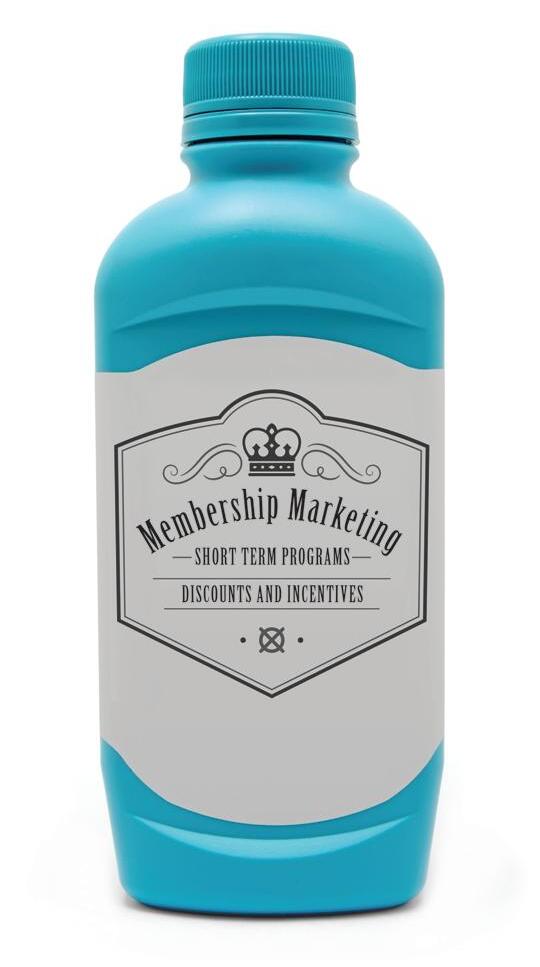

www.ClubMark.com/MembershipMatters

It has been just over a year since development of the hospitality-specific search site: PineappleSearch.com began development and launched seven months later in October 2015.
The site, produced by Hospitality Financial and Technology Professionals (HFTP ®) and powered by Hsyndicate, provides an aggregated content destination that focuses on news, articles and reports of primary interest to the hospitality industry. This includes club-specific resources, with priority placed on informationbased results.
The site is a super-charged resource, with numerous functionalities to help customize a hospitality-specific search. In other words: get results specific to clubs without having to cull through commercial links.
The Pineapplesearch platform exclusively builds its contents by aggregating more than 600-plus relevant and curated industry sources, using publicly available rSS and XML feeds. The site also goes beyond a basic search engine with its highly-customizable features allowing users to narrow search results, as well as tailor the site to hospitality-specific interests.
Here’s how it works: The Pineapplesearch platform exclusively builds its contents by aggregating more than 600-plus relevant and curated industry sources, using publicly available RSS and XML feeds. Pineapplesearch does not use algorithms to ‘spider’ the internet for content.
The site also goes beyond a basic search engine with its highly-customizable features allowing users to narrow search results, as well as tailor the site to hospitality-specific interests. In a basic search, a user can narrow results by: date, information type, category and region.
The site also has a database of organizations including club-related associations and resources. Once registered, a user has access to quite a few options:
Areas of interest — Select from a checklist of interests and the news that appears on your homepage will be related to those chosen. You can also add a topic of interest from a plus icon on the search results page.
Read list — Add an article to a list for later reference by clicking on the heart icon to the left of the headline.
Alerts — Receive email alerts on a pre-selected topic by clicking on the bell icon at the top of a search results page.
Rate content — Give a thumbs up or down on an article, bringing the more relevant content higher placement in search results.
We are one-year in since the start of this project, and while the platform is strong, we are always looking to build content. This is how we are looking for assistance from those in the industry to make it an invaluable resource.
To participate, we are seeking content suggestions, and have made it easy to do so.
PineappleSearch will index any type of content as long as suggested links have a B2B relevance for the hospitality industry in general, and links are of non-commercial nature.
If you haven’t visited the site, I request that take the time to do so. Enter in a search for your business-related searches.
Once you have given it a test-run, please send in your feedback and content suggestions to info@pineapplesearch.com. This is a site built as a resource for the industry, and it can only get to an optimal level with input from you. BR
Eliza Selig is the HFTP director of communications and can be reached via email: Eliza@hftp.org


We’ve all heard it before, and it makes perfect sense.
In fact, if we dusted off the latest copy of your club’s membership marketing plan, chances are the number one (and possibly only) strategy for new member recruitment is the referral campaign – a specialized campaign that incentivizes existing members to refer their friends, neighbors and colleagues as prospective new members.
I’m not here to tell you different.
But if you’re like the majority of private clubs today, you might have an aging membership or any number of other factors that have rendered the referral well dry, and tapped out most of the viable member referred candidates for membership.

So you need to reach new people, but options are seemingly limited and also relatively tapped out. Traditional club marketing prescribes that you buy or rent a list and blast an email, or mail a letter or invitation, or if budget allows, a postcard or other piece of nice collateral.
But deep down you know that these methods are no longer effective for lead generation. You know this because like me, you too get hundreds of emails each day, and like me you probably sort your mail over the garbage can.
In the past few months, the most important places on the internet like Google and Facebook have been quietly perfecting something known as lookalike audience targeting or match targeting.
It’s a modern solution to an increasingly difficult problem – how to get the attention of the right people. Lookalikes are simply a better way to reach new people who are more likely to be interested in your club because they’re similar to people you care about.
Lookalike audiences can be based on a variety of sources (i.e. people who visit your website or existing customers and members).
For private clubs, lookalike targeting is a total game changer in terms of membership lead generation. That’s because lookalikes are the modern equivalent of the traditional membership referral program.
Consider this – when deconstructed, a referral program is intended to leverage the people we know and like already (the “seed” audience) to help attract others of a similar demographic profile, with like interests, preferences, backgrounds, and behavioral attributes to the club. Most call these people friends. Marketers call them lookalikes.
I know what you’re thinking. You may want to buy a lookalike email list.
Nope. A lookalike isn’t actually an email list at all. Rather, it’s like an invisible audience that represents the overall composite profile and marketing characteristics of the entire seed audience, from which you can layer in additional targeting.
Or in non-marketer speak, it’s like an invisible list of people who have a really high probability of meeting your ideal criteria that you can use for marketing purposes on that specific platform.
It’s essentially a very specific and targeted audience that looks like your established members, plus or minus any other targeting attributes you want to include or exclude. The lookalike audience can then be used to increase visibility on Google or Gmail, or tell stories, amplify content, and drive awareness on Facebook or Instagram using native dark posts (content that can only be seen in the newsfeeds of people who meet the lookalike audience targeting criteria).
“In times of life crisis, whether wild fires or smoldering stress, the first thing I do is go back to basics.” – Edward Albert
When your numbers are going down or are stagnant and you are not sure what to do next, the best remedy is to go “back to the basics!”
Concentrate on the key components that drive membership - X and Y, which gets you to Z – the desired number of new members.
X represents the number of new prospects identified. Y is the number of tours conducted, and Z is the number of new members you admit into your club.
It takes X number of prospects to generate Y number of tours to realize Z number of new members. For example, out of 20 new prospects (X), you may generate five (Y) tours (25 percent) and sign one (Z) new member (20 percent), which results in a five percent rate of converting prospects into members.
Are you tracking these numbers (your conversion rate) each week/month using effective CRM (customer relationship management) software?
A number of applications are geared specifically to private club membership marketing. Diligently using this software prevents prospective members from being “lost in the cracks,” keeps you on point for timely and effective follow up, and provides relevant reports.
You can use the technology to track your prospects through the entire sales process, generate your close ratios and evaluate your most effective activities. You can easily keep score of both effort and results. Doing this allows you to know where to concentrate or change your efforts.
If your X (new prospects generated) is going down, or not rising fast enough, why not? Are you receiving fewer referrals from your members? Are your members “raving fans?”
When was the last time you measured the members’ evaluation of the overall member experience in your club (annual/mini member surveys)? Going too long without knowing how your members feel about their club can prevent you from being aware of deleterious changes in the members’ perception of the price/value relationship, which translates into fewer referrals.
Are you using social media effectively (not only for marketing to new members, but also in communicating with current members)?
Everywhere we hear, “We need new younger members” and those younger members communicate primarily on social media.
Do you have a weekly prospect development plan – and, again, with the right software, measure your efforts weekly? Here is an example of PCA’s weekly effort quotas:
1. New prospects contacted and added to prospect file
2. Follow-up calls/conversations /trial closers
3. New membership applications received this week
4. Sales closing ratio
5. This week I spent approximately ___ % of my time selling
6. Networking functions/community events attended
7. Member calls and visits
8. Corporate member calls and visits
9. New member enrollments/orientations
10. New member 30-day follow-up calls/ ask for referrals
11. New member application references checked
12. Guests contacted
Next let’s analyze Y. If you are giving abundant tours but not “closing the sale”, what is happening, or not happening? Are you losing market share to your competition? Are you conducting a competitive market analysis every six months?
Do you know where your competition is with pricing, programming, facilities, reputation, and membership flow? Are you analyzing the objections you hear? What can you do to overcome those objections in the short term? Are you studying sales and closingtechniques? If you had an acceptable closing ratio and it has gone down, what has changed?
As soon as you correctly analyze the issues you will very quickly see your Z rise. BR
Ted Robinson is a partner with Private Club Associates and can be reached at (478) 741 7996 or via email: tcr@privateclubassociates.com


“When writing the story of your life, don’t let anyone else hold the pen.”– Harley Davidson
“The survey says…” referring to a term coined by the television game show, “Family Feud”, may be an appropriate metaphor related to your club member satisfaction survey.
It’s likely you are optimistic that the most popular answers in your survey are those that lean toward extraordinary member satisfaction. However, that may not always be the case and there is an opportunity to reveal the truth of how happy your members are and the story of how they desire to live their club lifestyle. Your members may be perfectly content but, wouldn’t you like to know for certain and give them a voice to be heard? If you haven’t considered surveying your members think about what the final results might reveal and how helpful that might be to the overall club operations.
If it’s all good news, then that is something to boast about and share with the membership! If it’s not, then there’s work to be done that you may not have known about before a survey was conducted.
Member satisfaction survey planning from soup to nuts . . . and I’m not talking about the survey monkey (internet based) kind. I’m talking about one that is custom built, drilling down to the nitty gritty!
Satisfaction surveys can be tricky. They should be designed specifically for your club with the help of an industry survey expert who is equipped with state-of-the-art computer software programming that will deliver results in a compelling usable format. Anyone can put together and send a survey. However, the purpose is to capture member data in a way that your club can easily assess how different groups of members answer the questions they are asked. This not only gives you statistics on what is working well but also exposes information you can use to course correct, develop new programs or change member options.
“If your happiness depends on what somebody else does, I guess you do have a problem”
— Richard Bach, author
Begin developing survey questions for each department with your survey expert, who knows exactly how to piece together departmental questions that provide practical outputs. Many clubs allow members to provide open-ended comments at the end. Keep in mind this is a
place for members to vent, is usually negative and most often the result of a single incident.
On the other hand, they may reveal a common pattern as different members share the same information. The survey length depends on the patience threshold of the membership. If it’s too long you risk the chance of members losing interest as they fill it out. As deadlines are developed, consider giving members enough time to begin and return later to complete it.
Emails with instructions and the importance of participating should be planned and sent out strategically during the established timeline, along with other forms of communications such as table tents, flyers and posters.
Consider the time of year when sending out your survey. For example, in the southeast where the season begins in November, a survey launch mid-January might be considered best – after the holidays are over and visiting families have headed back home –when everyone is present. Once the results are received, an executive summary should be shared with the board pinpointing highlights. As your club develops year-over-year data you can then benchmark the results to keep on track. A survey expert can also provide a state-of-the-industry trend report as a comparative analysis to see where your club fits in. A summary of all the survey questions and answers in an email communication should be provided to the membership and posted on the private section of the club website for members to access.
“Everyone you meet knows something you don’t.” – Bill Nye
Post survey, each department results should be shared and reviewed with the executive team. Having survey results that provide in-depth data using demographic qualifiers will give the departments the information they need to establish how groups of members answered the survey. Having information broken down into age groups, membership type, gender, length of membership and time spent at the club establishes the ground work for the future.
A survey can be an extremely useful management tool. And as ‘the survey says…’ there’s no better way to identify member satisfaction. BR
Rosie Slocum, MCMP, director of membership, BallenIsles Country Club, Palm Beach Gardens, Florida. She can be reached at (561) 627-3372 or via email: rslocum@ballenisles.com www.ballenisles.org
deadline 10/31/2016 The BOARDROOM magazine is now accepting entries for its 2016 "Excellence in Achievement" Awards. The awards recognize both vendors and educators for their impact, achievements and contributions to the club industry. All award entries and nominations must provide supporting materials to be reviewed by an independent panel of industry experts representing various aspects of course and club operations. Winners are selected for overall excellence in their respective fields, innovation, vision for future growth and continued impact on private club operations. Winners in each category will be featured in an issue of The BOARDROOM magazine in 2016. For more information, call (949) 376-8889 or email John Fornaro at johnf@apcd.com or visit www.BoardRoommagazine.com.

Nominating (if different from above):












Include the following supporting materials: 1) A one-page explanation of why the product/service/company deserves to win its category in 2016, 2) media kits, 3) press releases, 4) testimonialsand 5) marketing materials.
Mail entry form, supporting materials and $50 processing fee per entry to: The BoardRoom magazine “2016 Excellence in Achievement Awards” PO Box 9455, Laguna Beach, CA 92651 or FedEx to 1100 South Coast Highway, Suite 309, Laguna Beach, CA 92651
CATEGORIES MAY INCLUDE: Course Architect (new course), Course Architect (renovation), Course Contractor/Developer, Irrigation Company, Course Equipment Manufacturer, Course Maintenance Company, golf Cart Company, Turf Maintenance, Fertilizer, Clubhouse Architect, Clubhouse Builder, Clubhouse Interior Design, Master Planning, Fitness Consultant, Fitness Equipment, Furniture Manufacturer, Outdoor Furniture, Outdoor Cooking, kitchen Equipment Manufacturer, Food & Beverage, Banquet Equipment, Pro Shop Interior Design, Menus, Amenities Provider, Apparel Provider, Clubhouse Signage, Tennis, Lockers,
Marketing, Photographer, Private Club Marketing, Lifetime Achievement, Jim Singerling Leadership, Boardroom magazine Dedication, International Leadership, gary Player Educator, The Jay DiePietro Vendor, Apparel Company, Association Program, Association, Club Management Company, Consultant Company, Club Services Association, Developer, new Product, Purchasing Services group, research and Data, real Estate, Winery and more.

Arnold Palmer once said, “Golf is deceptively simple, endlessly complicated.” I would like to borrow the sentiment for service. Creating WOW service is deceptively simple, yet endlessly complicated. If it weren’t, everyone would be doing it!
The Ritz Carlton, after whom many of us in hospitality model our standards, will tell anyone how they do it. That makes it simple – it’s available to learn. However, many organizations do not have the 360-degree dedication and customer focus it takes to make this level of service a reality. This is where the endlessly complicated comes into play.
The biggest challenge is how to bring your credo to life. The first step is to realize we are in the relationship business. I see many boards of directors discounting their general manager’s skills in the relationship building area because they do not understand the time and attention it takes or the value created by building these relationships. On the flip side, I also witness many young managers not realizing the importance of ‘face time’ with members and employees. Bringing your credo to life is more complicated that it may first appear.
1. Members value what they cannot buy. It’s not just about the golf course, the merchandise, the fitness equipment, childcare or the food. Members value a smiling face, a friendly voice, opportunities to create memories, and great, knowledgeable service. Creating and maintaining sincere, positive relationships provide a club with a competitive edge.
2. Empower employees. To provide member service one must be able to meet needs quickly, without complicated layers of involvement. Staff training to anticipate members’ needs and service recovery is critical to a club’s success. Employees must be taught how to make empowered decisions and look for ways to ‘fix it forever’ so the situation does not happen again.
3. Performance management is a must. Leadership must be actively engaged in the development of the team. If someone steps out of line with the club’s values, a serious decision must be
made. If a manager becomes aware a person has been placed in the wrong position for their skill set (i.e. promoted from within to a wrong fit position), it must be confronted immediately so that the employee does not fail. Failure to correct misplacement or not address performance issues will result in disengagement and eventual turnover in the position, possibly losing a great employee.
4. Strong employee engagement. Employees value a motivating work environment. Yes, their pay is important but so is working in a special environment…one in which they feel respected, appreciated and valued as part of the overall team and club’s success. J. Willard Marriott of Marriott Hotels phrased it this way, “Take care of your people and they will take care of your customers.”
5. Look for ways to create memories. Ultimately, we want our members to walk away with wonderful memories they will treasure and share with others. This is how we become the first place they think of for a wedding, a golf event, or a simple drink with a long lost friend. People, not things or technology or amenities, bring your credo to life.
6. Close attention to the fine details. Focused attention to the small details will make your operation first-class.
Imagine a world where you were greeted warmly as you entered the airport, a daycare, hospital or supermarket. Everyone wants to feel welcome. Then, strive to make your members feel understood and important, while making them comfortable.
Yes, it is just that simple, but the endless complications arise when we fail to remain committed and focused on creating relationships every day. BR
Whitney Reid Pennell, president of Reid Consulting Services, Inc. (RCS) is a celebrated management consultant, educator and speaker. Ms. Pennell is the creator of Food and Beverage Service Boot CampTM and two online RCS signature-training courses, Private Club 101 and ENCHANTED Service. For more information, phone (623) 322-0773; or visit the RCS website at www .consultingrcs.com. Whitney can also be reached at whitney@consultingrcs.com.


Who is your choice as the top private club board president?
Many people and companies associated with the private club industry are given due recognition for their accomplishments, and now Boardroom magazine is focusing on selection and recognition of the Private CluB Board President of the Year.
Boardroom magazine, through a nomination and selection process, will honor 20 board president finalists worldwide and one prestigious distinguished President of the Year award.
The top 20 private club board president finalists will be selected by a Boardroomcommittee comprised of industry experts and sponsors, who can make an expert judgment, who have an understanding of the industry, the structure of the board of directors, and the role and responsibilities of a club’s board of directors. A third party accounting firm will audit results.
A special section published in Boardroom magazinewill be devoted to the announcement of the toP Private CluB Presidentsand the distinguished President of the Year.
Visit www.boardroommagazine.com to download the criteria and application form. Entries must be submitted no later than Friday, november 17, 2016. For further information contact John Fornaro (949) 376-8889 ext. 2 or johnf@apcd.com

“Chris,” says Jan, the assistant manager, to Chris, the general manager, “I know how to do that, I do it all the time.”
“Well, Jan, but…”
“I always do this the same way and the members love it, everybody loves it.”
“Jan, I know you’ve been doing this a certain way, but… Oh, hello George, come on in. Jan, we can talk about this later.”
George, chair of the green and grounds committee, has his own suggestion for Chris. “Chris, why don’t we use Weed-B-Gone on the fairways. It works great on my yard, all my neighbors use it. Maybe it can make a difference for us.”
Competence is defined as the ability to do something well. Here, Chris has some issues with an assistant manager and a director who both have high opinions of their competence in particular areas. While addressing the issue of staff competence is perhaps easier overall than addressing director competence, both have their challenges.
A significant challenge in helping someone to become competent is that, according to Peter Brown, Henry Roediger, and Mark McDaniel in their book “Make it Stick.”
Incompetent people tend to overestimate their competence and, in so doing, see little reason to change their behavior or manner of thinking.
We tend to create life stories that explain our worlds and how we fit into it. Incompetent people may lack the skills to improve because their self-perception prevents them from realizing that they are not competent.
According to David Dunning and Justin Kruger in their paper “Unskilled and Unaware of It,” incompetent people can be taught to raise their competence by learning to judge their own performance more accurately. This can be accomplished by providing training for staff, feedback about performance, and social comparison feedback.
Chris will be able to train Jan and provide formative feedback, but the director may require other tactics. For George, social comparison may be helpful. Chris could gently provide some information about how other green and grounds directors before him, or at other clubs, perform their duties. Chris can emphasize the fact that previous directors didn’t worry about the details, but stayed above the small stuff and concerned themselves with the bigger issues.
However, addressing the issues of staff and director competence can be further complicated by the presence of a powerful trap: sometimes, the GM is also incompetent and unaware of it!
According to a survey we conducted, the number one reason given by responding presidents for the termination of a manager was incompetence. We’ve all heard of managers who have been terminated, and their response was “I never saw it coming.”
We need to be aware of our weaknesses. We should always be aware of possibility that we have fallen under the delusion that we are better than we are. It is very natural for all of us to think that we’re above average, so the key is to have a control mechanism.
Data and facts are very handy, and having a confidant whom you trust to give you the unvarnished truth is helpful. Feedback is the best form of reality check. Unfortunately, the GM might not be getting appropriate feedback from those who know it best – subordinates.
Being open and honest with those who report to you will be very helpful in discovering your own areas of incompetence. Ask for feedback, and then be open and positive when it’s given. BR
MacDonald Niven, CCM, CCE is the general manager at La Rinconada Country Club in California and can be reached at (510)-439-8522 or via email: mac@niven.cc.
BY KRISTOFER J. FAIR
So many clubs speak about their club culture while courting new members, but so very few ever really celebrate it.
In the board rooms board members try to convince one another that they should be more like Merion or Oakmont or Pine Valley. Why?
Don’t we need all 26 letters in the alphabet to speak our language – and don’t we need all 23 pairs of chromosomes to build our physical DNA? Likewise, we need clubs of diverse cultures to grow the private club industry.
Don’t get me wrong there is absolutely nothing wrong with being the best. Celebrate your own club if it is absolutely the best mid-tier private club in an area with a rich history of great clubs. Celebrate if you are the best, least expensive club.
A stunning culture isn’t about entry fees or dues but rather people, programs, and a healthy respect for tradition. What we need is to stand out, not by just being different but by being absolutely outstanding at delivering our
brand promises to our membership. Don’t be different by allowing juniors to play at 8 on Saturday morning; be different by having the most dynamic juniors’ program that teaches integrity, great golf skills and respect.
There are so many moving parts to test success of being outstanding: the budget, member attrition, member wait list, employee happiness, participation in club events, and how full the dining room is night after night.
My club’s success isn’t being more like another club. It is being exactly the way my membership desires their club to be and to be that on a consistent basis.
Here is to celebrating your club’s unique culture and its success. BR
Kristofer J. Fair is the general manager of Blue Bell Country Club in Montgomery County, Pennsylvania. He is a past president of the Philadelphia Club Manager’s Association. His writings can be found on his blog, Private Club Insight. Kris can be contacted via email: golf.kris@yahoo.com


Numerous surveys indicate that the most important element of the golf experience to most players is the condition of the course, especially greens.
The golf course superintendent’s impact on this is obvious. How they accomplish the goal of providing consistently good conditions can be the difference between economic success and failure.
Club Benchmarking (CB) indicates that private clubs average between 30 percent and 37 percent of gross revenues being allocated to their golf course maintenance budgets. This is the largest allocation of available resources at most clubs and is often considered the most critical.
Often, revenues dictate the level of maintenance and course conditioning often impacts potential revenue. If it sounds a bit “circular”, it is. Over 70 percent of private club members indicated the main reason for joining was “the high quality of the golf course.” Combined with the fact that most golfers don’t know Donald Ross from Donald Duck, maintenance is a critical factor in golf course economics. How do club members and leaders know what to expect and where (when necessary) to cut?
Each course should have a written maintenance plan, with specifications in detail that allow management/leadership and the golf course maintenance crew to assess accurately the cost and benefit of each of the specific practices.
As living, breathing and growing systems, golf courses evolve and change with seasonal and weather impact. Members and boards don’t always understand this. A written golf course maintenance plan can improve the communication between superintendent and club leadership so that everyone knows what’s expected.
What’s in a maintenance plan? A good maintenance plan (at a minimum) includes the following:
• Mowing heights and frequency
• Bunker maintenance
• Schedule of aerification, verticutting, topdressing and other procedures
• Hole and marker movement
• Divoting
• Fertilizer, chemical and pesticide application
• Irrigation
• Staff planning, and
• Equipment.
Changes in the golf course maintenance budget will impact each of these elements and when
those changes come, club leadership can make informed decisions on what is considered essential and what they can live without, as well as what might need improvement.
With the sometimes-fickle nature of club politics, a written, an approved maintenance plan can be invaluable to both the superintendent and his crew, as well as the board and membership. A well-crafted plan can serve as a common ground when questions or disputes arise about the playing conditions, and club leadership can make informed decisions about what and where to cut when budgets are stressed.
Since the superintendent is often the “fall guy” for the less then desirable conditions that result from excess play and poor weather, an established and approved maintenance plan can often be used to demonstrate to club leadership the practices that were employed and how the course can return to expected playing conditions.
A written maintenance plan can also help the superintendent impact the bottom line.
Expense management: This can be a tricky area. Once budget cuts begin, it’s usually only a matter of time before playing conditions are compromised and players/members notice. When that happens, revenue declines and more budget cuts are soon to follow. On a golf course, effective cost management can involve a variety of practices that shouldn’t harm the revenue stream, including:
• Efficient use of equipment
• Efficient irrigation
• Enhanced time management
• Weather-based management, and
• Play-based management
Revenue enhancement: The obvious ways a superintendent can enhance course revenue include:
• Providing premium conditions
• Schedule agronomic practices to avoid busy times or special events, and
• Communication.
It’s critical that club management/leadership become informed about maintenance practices and a maintenance plan enhances their education. BR
Larry Hirsh, CRE, MAI, SGA, FRICS is the president of Golf Property Analysts (www.golfprop.com), a leading golf and club property consulting, appraisal and brokerage firm based in Philadelphia. He blogs on variety of club and appraisal issues at http://blog.golfprop.com



As summer starts to wind down, this is an important time for golf and country clubs. This time of year give us a chance to analyze successes we have had through the year and at the same time make adjustments where needed.
Many of our conversations have some reference to football. “Will the draft picks from last April pan out for your favorite NFL team?”, “What college conferences will represent in the BCS”, “What’s the latest with Johnny Football?”, and of course “Who is your sleeper pick in Fantasy Football”.
In the January/February issue of Boardroom, Dean Wochaski ‘s article “Where’s My Playbook” focused on the fact that as active members and committee participants, there is no written playbook to guide us through our active involvement. It also detailed some excellent best practices in planning for the 2016 season.
As we enter fall, take a good look at how this year has gone so far. Just like any great quarterback, now is the time to call your audible. If there have been great successes to date, look at how your club can build on these to insure sustainability and adjust programs / project plans as needed.
If there have been challenges, having plans in motion now to create end of year success is very important for the future of your club. We often see golf courses get into September and start to react by reforecasting expenditures in hopes of making up for lost revenues. Is this really the best plan? For some this may be one piece of the puzzle, but for others there is more to it than just cutting expenses.
We know that course conditions are the foundation for a successful country club experience. Fall is a critical time for growing healthy turf. Fertilizer reduction, chemical reduction and labor reduction are all typical discussion points when trying to get back to even on the income statement. But are they the best solutions?
We know the importance of sound agronomics in the fall and how they translate into success the following year. It is very important to go back to your personal playbook and work with the super-
intendent and your finance committee to see what are the best audibles to call. The key to planning through the rest of the season is open communication and creating a plan that will help insure success and sustainability throughout the rest of 2016 as importantly into 2017.
The best time to make adjustments for the following year is when you can still touch, feel and observe current conditions. There is nothing better than making plans based on “real time” rather than in the boardroom at the end of the season.
Many clubs are creating budgets as we move into fall. The time is now to create plans that insure your achievements in 2016 continue into next year. It is also the time to re-assess your needs versus wants for next year and how to successfully implement your needs.
Just like any great coach or player, have your plans laid out with clearly defined goals. Create your personal playbook for 2017 and communicate clear expectations to your superintendent and committee members. This is more than just creating a budget number. Some key points in planning should include:
• Clearly defined maintenance standards specific to your club and your individual club identity.
• Specific agronomic plans developed to insure quality turf the rest of this season and every year ahead.
• Balanced labor tasking / evaluation for the right number of employees to help produce consistent standards (not over producing and not under producing) to insure financial success.
• Capital and equipment needs listed and tracked as executed.
Now is the time.
Call your audibles for this year. Create your plans for future success and sustainability. BR
Steve Schendel is vice president / agronomist, Golf Maintenance Solutions. Steve can be reached at (630) 613-9259 or via email: steve.s@golfmsolutions.com
Recently while being interviewed for a documentary on golf course green failures it occurred to me that many of the questions that the interviewer was asking are questions anyone in a golf course management position would ask.
So here they are along with my answers.
Question: After 26-plus years of working with golf course greens, what is the most important thing that you have learned?
Answer: P lants need oxygen and standard water is not a good thing. I first heard that statement almost 30 years ago from my mentor Dr. James Watson, so I cannot take credit for it. However, we have discovered how much oxygen a plant needs and the amount of water that needs to be retained in the green’s mix.
Q: What is the main cause of a green’s failure?
A: Lack of oxygen.
Q: What is the main cause of lack of oxygen in the root zone of a green’s mix?
A: Lack of space in the air pores. To understand this answer, we must first understand what makes up a green’s mix…it’s composed of solids and pores (the spaces between the solids). The larger pores hold oxygen and the smaller pores hold water.
Since roots take in oxygen they can only live in the larger air pores of the green’s structure. The roots of a grass plant produce organic matter (much like our skin produces oil) and since roots can only live in air pores the organic discharge is deposited in these air pores thus reducing the number of air pores available to hold oxygen. As this organic grows it can reduce the amount of space in an air pore to the point where there is very little room for oxygen.
Q: What do physical properties refer to in a golf green?
A: Most people think of infiltration rates when looking at or discussing physical properties. However, I’m more interested in the air and water pores being in balance with each other, preferably a one to one ratio.
The next thing I’m interested in is the percent of water holding. Physical properties should include: water holding infiltration rates, air pores, water pores, total porosity, compaction, and organic content measured in one-inch increments.
Q: Physical properties change. What are the main causes of these changes?
A: Organic build up and quality of irrigation water.
Q: Considering these changes, how often should a golf green be tested for physical properties?
A: Every year for the first five or six years until the ageing process stabilizes and there are steady results from the agricultural program. After the stabilization every other year will be sufficient.
Q: By maintaining balanced physical properties we will contribute to improving the environment?
A: If balanced physical properties lead to healthier turf than the answer is yes. Plants take in CO2 and produce oxygen. The more plants, the more oxygen.
Denser turf equals more plants. Research has shown that greens with balanced physical properties and healthy turf require 20 to 25 percent less in their need for chemicals.
Q: These tests from ISTRC, allow us to be be proactive in our agriculture practices. What do you mean by being proactive?


Growing the game of golf is essential in the years ahead.
A large part of growing the game will be to keep the game affordable for the masses. While the golfer may not realize it, those in the golf business understand that one of the largest cost considerations is the labor required to maintain and operate a golf course.
Staffing considerations hit their highest levels at the turn of the century. A tremendous amount of competition for improved playing conditions arose across the country. The inputs for those cultural practices that would provide firm and fast conditions became a major consideration for membership satisfaction, and as marketing for new members.
The most efficient time to prepare the golf course is when there is the least amount of interference to play. Consider a larger component of part-timers. Imagine increased staffing levels from 6 a.m. until 10 a.m. with fewer people working when the golf course gets busy. Staffing can ramp up again after the last tee times and that’s a great time to mow rough and fairways.
As golf play declined, along with the economy, am few years ago, it created a much different scenario for the golf business. Course operators and golf course superintendents used their inge-
nuity to develop strategies for downsizing their staff. What seemed like a temporary situation became more permanent and is now considered “rightsizing” by most.
Many of the private clubs, I am familiar with, have seen a reduction of 20-25 percent of their staff during that time period.
With a staff of 20 that may not seem like much but consider four full time employees as 8,000 man-hours a year. Surely accomplishing former levels of the highest standards is highly unlikely, so an adjustment to several things must take place to be competitive in the marketplace.
Recent legislation has required that employers cover the health care of full time employees. In some cases, this has resulted in the use of more part-time help. Golf course superintendents should embrace a new labor force pool and actively pursue part timers as well as retirees to get work done, without taking on additional expenses.
Recent legislation has dealt with businesses not paying overtime for jobs that are not considered as true management positions. While each state may have different rules it is important that you analyze positions such as the assistant, 2nd assistant, assistants in training and interns to see that they meet the criteria for salaried positions.
Several golf clubs have encountered visits from the Wage and Labor Bureau and have resulted in back pay for certain positions that were deemed more labor than management. Hourly pay will resolve this potential problem but many assistant superintendents work 50 or more hours a week during the high season.
The state of California has approved a minimum wage increase that will be implemented
in phases over the next few years. It is inevitable that other states will follow, so be prepared. If staffing levels remain the same at clubs, a 50 cent/hour wage increase will result in an $80,000 increase in wages in the first year. The second year of implementation would result in a $1/hour increase or an additional $160,000 in budget expense. So in two years this would amount to $240,000 or almost a quarter million dollars in budge increases.
As entry level wages increase so will the staff with tenure at levels slightly above minimum wage. It will take three to four years to reach the new minimum wage levels and clubs will need to be very creative in all departments to keep costs under control.
For years restaurants have staffed for the flow of the business. Golf course operations need to do the same now, more than ever before. The most efficient time to prepare the golf course is when there is the least amount of interference to play.
Consider a larger component of part-timers. Imagine increased staffing levels from 6 a.m. until 10 a.m. with fewer people working when the golf course gets busy. Staffing can ramp up again after the last tee times and that’s a great time to mow rough and fairways.
Creative golf course superintendents are using a variety of labor sources:
• Retirees
• Homemakers
from Green Committee - Doherty |55
A: In the past we waited until our turf started to stress before taking corrective action but now by monitoring the physical properties on a regular basis and understanding how the green is ageing we can take action before the turf starts to stress.
Q: If the physical properties are always balanced air to water, will the turf always be healthy?
A: No…balanced physical properties are the foundation and a must for healthy turf. However, we have found that the air pores can become contaminated with sewer gas (CO2, methane and hydrogen sulfide are the main components of sewer gas) and as many greens fail from this contamination as they do from excessive organic build up.
Q: Where do these sewer gasses that cause green failure normally come from?
A: Drain tiles. Most greens built over the last 40 years have a drain tile system under the green’s mix imbedded in
• High schoolers looking for summer work
• College students looking for summer work
• Golf team members at high schools or colleges
• School teachers
• Veterans
Millennials like the options of a flexible schedule that meets their needs. Take that into consideration, rather than being locked into a 6 a.m. until 2:30 p.m. timeframe. Part time hourly staff will be a key to success in the years ahead.
Key elements to keeping your costs under control include:
• Foreseeing changes in the economy and labor regulations
• Adjustment of golf course standards to a realistic match of available labor
• Implementation of modern hiring and staffing techniques to match the available labor pool.
As in the past, golf will find a way to manage what lies ahead. It will take a cooperative effort by ownership, management and department heads to develop and implement plans to evolve into this new era. BR
Bruce R. Williams, CGCS is international marketing manager for Grigg Bros./Brandt and a past president of GCSAA. He can be reached at: brucewms1@hotmail.com
gravel. As water passes through a green it enters this system of drain tiles and is carried away from the green to some distant destination.
If this drain system is compromised and the water cannot travel away to its designated destination it sits and becomes anaerobic because of lack of oxygen. The gasses produced by the anaerobic water will rise and travel up through the drain tile system and into the green’s mix where they will reside in our air pores.
Once the sewer gasses replace the oxygen in our air pores it means stressed turf and disease.
These questions and answers can help with your ongoing effort to better understand your greens, because it pays to never stop learning. BR
Dave Doherty is CEO and founder of the International Sports Turf Research Center, Inc. (ISTRC) and holds three patents regarding the testing of sand and soil-based greens. He can be reached at (913) 706-6635 or via email: daveistrc@hotmail.com www.davedohertyistrc.com


“Thank you” is a simple phrase that means so much. Yet, we often save it for special occasions or for someone who comes to our rescue in a time of need.
I know I don’t say “thank you” nearly enough to my wife Colleen, who takes care of things at home while I am on the road for business on behalf of the Golf Course Superintendents Association of America (GCSAA).
But it’s not only an important sentiment to express in our personal relationships; it’s also vital to communicate appreciation in our professional roles. I hope each of you take the time to thank your staff for a job well done.
Studies show that employees will work harder when their boss shows appreciation for their work. Saying “thank you” is a sign of respect for another person, and it indicates you don’t take them for granted.
I truly hope golfers have taken the time to say, thank you to superintendents for their work in the golf course management profession. After all, they take care of the biggest and most vital asset any golf facility has – the golf course.
Perhaps you are seeing our “Thank a Superintendent” commercials on the Golf Channel. These spots featured some of the best golfers in the game offering the tagline, “If you love golf like I do, thank a golf course superintendent.”
This year, GCSAA added celebrities to the lineup of those offering to “Thank a Superintendent.” The new commercial stars Grammy-award-winning entertainer Justin Timberlake and NBA Hall-of-Famer Charles Barkley in a 30-second spot that will run through October on the Golf Channel.
Other celebrities taking part are NFL Hall-of Famer John Elway, actor Dennis Haysbert, Duck Dynasty’s Willie Robertson and former USA women’s soccer star Brandi Chastain. Elway, an accomplished amateur golfer, said during the filming, “It’s about time superintendents got some recognition.”
All the celebrities offered their time without cost to promote and thank superintendents while playing a practice round at the 2015
American Century Celebrity Championship in Lake Tahoe.
I hope that golfers everywhere will approach superintendents to say “thank you” in person. I have, in fact, had several superintendents tell me about those instances at their facilities. One was Paul Latshaw, certified golf course superintendent and director of grounds operations at Muirfield Village in Dublin, Ohio, the host course for the Memorial Tournament each year.
As you probably know, Muirfield is Jack Nicklaus’ pride and joy. And Nicklaus was the lead figure in the “Thank a Superintendent” commercial last year. He went out of his way to support our campaign, and he was just as gracious when I had the chance to thank him in person. He knows how hard his superintendent Paul Latshaw works.
The Latshaw family name is well known in this profession, and Paul came into this business following in the footsteps of his famous father, who worked at Augusta, Congressional, Oakmont and Winged Foot.
“My father was the best superintendent ever, and he casts a big shadow,” said the younger Latshaw, who is in his 13th year with Muirfield Village.
“I always have been a Nicklaus fan, even to the point of working some for his design firm early on in my career at Muirfield. Jack Nicklaus has always placed a value on agronomy and the superintendent. I don’t know of any other design firm that has had agronomists on staff or as consultants.
“So when he took the time to support us and our profession, that meant the world to me. I’ve had members too take notice and stop to say, ‘thank you.’ It makes me proud to be a superintendent, and I appreciate all that GCSAA is doing to elevate our profession. So, ‘thank you’ GCSAA.”
No, thank you, Paul. And thank you to all GCSAA members who work each day to provide the best conditions they can for golfers while protecting the environment and our natural resources. BR
Rhett Evans, CEO Golf Course Superintendents Association of America














Here’s some serious food for thought on how to commit to your culinary program.
Because I received such a large response from “Culinary Compensation: Put Your $$$ Where Your Mouth Is” (Boardroom, January/February 2016) I want, together with Executive Chef Penelope Wong of Glenmoor Country Club, Cherry Hills Village, Colorado, to dive a little deeper and focus on some strategies for dealing with the nationwide kitchen staffing crisis.
Committing to the culinary program isn’t just hiring an executive chef that can cook, listen, mentor, motivate, engage and execute. It’s also providing the tools and support (financial and otherwise) to deliver on and exceed member expectations in a sustainable way.
The shifting paradigm of attracting and engaging Millennial staff (born between 1980 and 2000) is key. Traditionally “private clubs” have focused on exclusivity and privacy. You don’t see “behind the walls” unless you are a member. Some clubs, even today, don’t put anything but contact information on their website except for a log-in for their members. How are potential staff members to get an understanding of what the club is all about?
So what better way to reach Millennials that came of age at the time of the internet and cell phones, than leveraging social media to break down the walls and attract staff to an opportunity that may otherwise be unfamiliar?
“In today’s workplace you have to sell your establishment. Making a social [business/recruiting] card to post on the club’s social media is important. Include a photo of the property, photos and descriptions of food the club offers, photos of the dining room, and include a least three benefits to working there,” says Maria Campbell, CEC, owner and social media expert at Imagine Impact (www.weimagineimpact.com), a kitchen consulting firm. She also recommends listing benefits to working at the club in addition to job responsibilities on all job postings.
Executive chef Michael Ramsey at Jacksonville Golf & Country Club, Jacksonville, FL, leverages
social media to attract staff. Using Instagram and Facebook, potential candidates get a glimpse of his kitchen operations. He is knocking down the walls in his recruiting strategy.
Executive chefs should create a LinkedIn profile and use that medium to recruit as well and it should be linked to the club’s LinkedIn company page that includes the business/recruiting information mentioned earlier.
Once you attract Millennials you must keep them engaged. “Cooks joining the profession now are more particular about the kitchens they want to work in, better equipped to move from job to job and from city to city, less willing to work long hours for low wages and more impatient to rise,” wrote Julia Moskin of the Chicago Tribune in her article, “Where Have All the Cooks Gone” (8/2015).
Successful chefs are finding out these days that they need to shift their management styles in order to gain an equivalent amount of productivity from their new Millennial staff as compared to the “old timers.” Gone are the days of chefs trying to get their message across by throwing plates and reams of plastic wrap across the kitchen because one of their cooks had three overcooked steaks returned.
Emerging now is a generation of executive chefs who are learning that teaching, motivating and inspiring are key in not only keeping good staff on board, but in attracting new candidates as well. The word gets around.
A new approach Penelope has taken with her staff is engaging them during the review process to discuss their personal and professional goals in addition to what she can do to help. Goals become more clearly defined with the assistance of a manager’s point of view.
A timeline is set along with measurable steps in order to reach those goals. This has been a very effective tool in not only managing individuals dayto-day but also aids in building a long-tenured staff who are given a sense of security in knowing that management is genuinely passionate about their future and career goals.
The Stay Interview is a great idea on how to keep Millennials engaged. Developed by Maria Campbell’s team, the stay interview is a “guide detailing eight questions created for food industry managers to empower leaders to engage in a new kind of conversation with the team.”
The questions are structured to help leaders gather information from their team on topics affecting staff’s overall satisfaction with their work. It is a proactive communication tool that not only provides the chef with valuable information but also gives the employee a feeling of control over their future.
The stay interview provides a proactive way to engage Millennials in shaping their future at the club. Not only do you gather important information about the things that motivate your team, staff members realize that you are very focused on their well-being and future. A factor that is very important to Millennials!
Visit unbouncepages.com/stayinterview to download the Stay Interview questions.
Another tactic is best described by Executive Chef Jonathan Moosmiller, CMC, of Southern Hills Country Club, Tulsa, Oklahoma. “I have had success recruiting from several different schools for summer interns and really focus on making sure that they have a good time and are educated while here. This has led to many cooks returning after graduation. The power of the kids going back to their schools and talking about their experience has done wonders for us.”
Penelope has started recruiting from different high schools that have students enrolled in a culinary program within the school’s vocational curriculum. This gives students interested in pursuing a culinary career the opportunity to work in a professional kitchen, learn basic fundamentals and expand their knowledge base before they even graduate from high school.
Upon graduation, the students have the tools necessary to decide whether or not to pursue a culinary education/career. If they decide to embark on a career in the culinary arts they have a foundation as well as an interest in where they want to intern and ultimately work – hopefully the club!
In our next article we will share more ideas on combatting the kitchen staffing crisis. In the meantime, we recommend incorporating the strategies listed to leverage social media, enhance job descriptions, and incorporate new management techniques such as the stay interview to attract and engage staff. BR
Lisa Carroll is a search executive and consultant with Kopplin Kuebler& Wallace, a consulting firm providing executive search, strategic planning and data analysis services to the private club industry. She specializes in executive chef searches. The company has offices in Scottsdale, Jupiter, Atlanta, Denver, Cleveland, and Naples. Lisa can be contacted at (561) 596-1123 and at lisa@kopplinandkuebler.com.
Penelope L. Wong is executive chef, Glenmoor Country Club, Cherry Hills Village, Colorado. She can be reached at (303)339-3559 or via email: Penelope Wong ChefPenelope@glenmoorcc.org
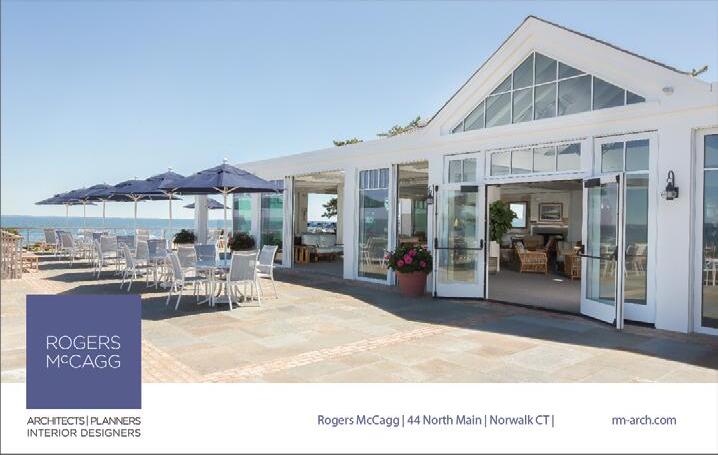


As we are all aware, not every private club plays by the same rules when it comes to catering and events.
For some, they can drive all the revenue they wish, and their catering and events department provides an incredible source of revenue that enables the club to fund capital improvements and keep member dues low. For these clubs, the ability to drive high-end event revenue is critical.
Other must abide by the “15 percent rule” in order to keep their tax status intact.* In this case, the few non-member events that they do take on must reflect the exclusivity and image of the club. What do both of these club types have in common? That they can both gain the event types they are looking for by understanding the luxury event market and those that service it.
Gaining event business through referrals is the preferred method of creating awareness and gaining this business, and the best place to start is with the high-end, luxury event and wedding planners.
This select group works regularly in the private club environment and understands the subtleties of working in clubs and interacting with members. To understand how and why a luxury event planner determines a venue for an event, I interviewed one of the best, Nikki Khan of Exquisite Events. She provided some incredible insight into this niche of our industry.
In the luxury event market, the planner is the person choosing the venue for 90 percent of the events. Only 10 percent of luxury event hosts hire a planner after they already have selected a venue. Some of the most important factors that a luxury planner considers when choosing a venue are:
• The style of the events and which is best, a city or country location?
• Do they need a total buyout of the property?
• “Load-in” space and timing of when they can begin set-up. Most luxury events need at least a couple of days in advance of the event for setup time and are willing to pay whatever it takes to have this time available to them.
• The exclusive feel of the property and ambiance
The availability of a security gate for the privacy of their high-profile clients and guests.
Private clubs can best position themselves to serve the luxury market by understanding the clientele, which is not difficult considering that it very closely resembles the profile of a club’s members.
It is very helpful to understand their lifestyle, travel habits, where they dine and the cultural components and traditions as they pertain to events of many different and prevalent cultures in your club’s surrounding area. The partnership between the planner and the club is of utmost important because it is all about the teamwork. It takes a village to produce an event and everybody has an important role.
Remember when working with luxury event hosts and planners that although the numbers are higher, there is typically a “budget.” Ask what the budget is in your first meeting to ensure that you are all on the same page. Before directly asking about budget, listen to the adjectives they are using to describe their perfect event – “over the top”, “elegant”, “one-of-a-kind”, etc.
Lastly, if you are looking to attract the luxury event market, make sure that you are providing a luxury experience every step of the way, for both the planners and the event host, as both are your clients.
From your communication, protocol for meetings with them, gifting, etc., everything you do and how you brand yourself should exude luxury. At this level, event planners really do become an extension of your team, so surround yourself with positive, enthusiastic people that you will enjoy working with.
You will find that most of them do not have that “diva attitude”, but rather are willing to “get their hands dirty” in the pursuit of delivering greatness.
*If you are looking to maximize the allowable revenues from your catering and events department in order to fund capital projects, please feel free to contact me – there are endless ideas! BR
Lynne LaFond DeLuca is the executive director of the Association of Club Catering Professionals and a private club industry consultant. In 2014, Lynne was named “One of the Most Influential Women in the Private Club Industry” by Boardroom magazine. You can reach Lynne at Lynne@TheACCP.com, or visit the website www.TheACCP.com.
from Legislative Committee |40
DOL to reanalyze the economic effects of this action, particularly on small employers and non-profits. The bill would also prohibit the inclusion of automatic salary updates in any future version of the rule.
It would also restrict the ability of the DOL to issue any changes to the existing duties tests without providing specific text in the proposed rule for public review and comment. In the Senate, the legislation’s chief sponsor was
from Membership Committee |44
The power rests in the fact that Facebook and Google sit on top of the largest collection of big data in the worldnot just what people put in their online profiles, search for online, or who they like or follow.
Facebook also tracks pretty much every website you visit, and has integrated and correlated all major third party consumer purchasing data from the big data providers into its database. Combine that with smartphone GPS tracking and you’ve got a database like none other that has ever existed, chock full of ways to get in front of the right prospective members. We’ve been blown away by the results so far. Lookalikes are generating three to five times the member-
Senator Tim Scott (R-SC). On the House side, Representative Tim Walberg (R-MI) is leading the charge. While this legislation is unlikely to become law, it sets the stage for further Congressional action to prevent the rule from becoming effective. BR
Melissa Low is the senior director, Communications & Advocacy, for the Club Managers Association of America. For the latest information on these and other issues affecting the club industry, please visit CMAA’s Legislative Report blog at www.cmaa.org/legislative.aspx.
ship leads as compared to standard targeting. There’s nearly a 40 percent increase in qualification rate across all our clients using them, and overall campaign ROI has nearly doubled for those using lookalikes for at least six months. With continued refinement and layering of additional targeting we expect these results to continue to improve, because as is generally the case with digital marketing, the more data you collect, the better the end result. BR
Learn more about Facebook lookalikes here: www.facebook.com/business/a/lookalike-audiences and Google Match here https://support.google.com/adwords/answer/ 6379332. You can also visit Pipeline’s website at www.pipelineinc.com or email info@pipeline-inc.com to learn more.


In his best-selling 2001 book entitled Good to Great: Why Some Companies Make the Leap...and Others Don’t, James Collins shared a simple concept that can change your club.
Collins took the story from Archilochus, a Greek poet, and told it in the form of a parable. The story centers on a cunning fox, who is expert in the many ways of the woods around him; and a hedgehog, which is described as simplistic and somewhat plain.
T he fox sets his mind on eating the hedgehog and spends hours plotting the perfect attack. Meanwhile, the hedgehog goes about its business, unaware of the impending threat to its simple life. When the fox attacks, the hedgehog rolls into a spiny, impenetrable ball. Undeterred, the fox kept re-strategizing, but the pattern repeats itself over and over.
“The fox knows many things, but the hedgehog knows one big thing,” the parable famously concludes. In its case, the hedgehog knew the most important thing: how to survive.
What distinguishes the great clubs from the good clubs? Great clubs focus on the basics, starting with the principles, values and priorities that define them.
Great clubs are characterized by dependable, trustworthy and resolute leadership: Leadership in private clubs is simple. Everyone wants to do it. The trick is choosing and sustaining leaders who are trusted, respected and able to make difficult decisions. They look to the mission and core values of the club for guidance, and then they ask questions before making important decisions:
1. How does our club’s mission influence this issue and the choices before us?
2. Is the choice (or choices) we’re considering consistent with the values of our club?
3. Is this choice consistent with our strategic plan?
Private clubs require servant leaders…those who place the needs of others ahead of their
own. Doing so requires a balanced understanding of boardroom strategy and operational tactics.
The best clubs have boards focused on strategy, the balance sheet and the future financial needs of the club. Like the hedgehog, great boards do not seek to be experts at all phases of club leadership…they focus on the things that matter most.
Top-performing clubs are distinguished by boards that require management accountability for tactical solutions. The best clubs see the manager as the tactical operator and make it easy for them to manage. They don’t seek to influence tactics. They make sure strong plans are in place and then they step into a support role.
Great clubs are open, consistent and deliberate: Except in matters of privacy, top clubs operate openly and do what they say they will do. Three consistent markers of the governance style of great clubs:
1. The rules of the club are exercised consistently and without passion, prejudice or politics. Everyone understands that the club will not brook poor behavior.
2. Governance is described within a board policy manual (BPM) that is available for all to see, and the board follows its own rules.
3. Boards in great clubs deliberate as many and govern as one. Differing and sometimes conflicting viewpoints are exchanged in the boardroom. Once a decision is made, the board stands unanimously behind it.
Great clubs are revenue focused versus expense focused: Revenue growth supports economic sustainability and funds future capital requirements.
Revenue growth comes from full membership rolls, innovative member programs that protect retention and non-member revenue sources.
Struggling clubs tend to manage expenses in the boardroom instead of leaving management to the manager and focusing their strategic energy and experience on quality and mission fulfillment that drive revenue growth.
Great clubs understand and reinforce their brands: According to data assembled by Global Golf Advisors, every major metropolitan area in the U.S. is over-supplied for private clubs. But most markets are characterized by clubs indistinguishable from the next. The most successful clubs understand the need for market differentiation and have clear answers to the following questions:
1. What sets our club apart from others?
2. If people do not join our club, where do they join and why?
3. What will future members of our club want from the club?
Clue: If you struggle over any of these questions and your answers require more than a sentence or two, your brand is not as focused as it needs to be.
Great clubs are guided by visionary, bold and thorough strategy: Strategy is the key. Does your club have a strategic plan? In great clubs (a) strategy is clearly articulated (b) the members fully understand the strategic goals
and objectives being targeted, and (c) the board tracks strategic performance at every board meeting.
In the great clubs, strategy is the primary focus of the board. Their boards routinely and consistently review portions of the strategic plan at every board meeting, just as they do new and old business, to make sure management is keeping the club on track.
Three steps that your board can take to be more effective in using strategy:
1. Make strategy a primary objective and accomplishment for every board year.
2. Keep the strategic plan current and active. Use and refer to it at every board meeting.
3. Keep the long-range strategic planning committee educated on current best practices in strategic planning. Don’t rely on strategic planning methods that are 10 or 20 years outdated.
Leaders of great clubs focus tirelessly on the priorities that ensure their survival and long-term success. They resemble the hedgehog more than the fox. BR
Henry DeLozier, a recipient of the BoardRoom magazine Lifetime Achievement award for 2014, is a principal of Global Golf Advisors. You can contact him at hdelozier@globalgolfadvisors.com.


The American writer, George William Curtis, was prophetic when he said: “It is not the ship so much as the skillful sailing that assures the prosperous voyage.”
Little did he know that today, his comments would hit the club industry head on. In this turbulent economic era, when members are not spending as much, new members are harder to recruit, and operational costs are rising, clubs face unprecedented challenges today and uncertainty tomorrow.
Boards and managers alike have to remember that the club’s goal is thriving, not just surviving. And the means by which a club thrives is to invest in strategic marketing instead of waiting for a change in market conditions. As contrary as this may sound, it is a time-worn approach that

Each club faces many difficult decisions, especially in tumultuous economic times. It’s too easy to make knee-jerk decisions when looking for cost efficiencies. This often happens when it comes to setting costs (dues, assessments, etc.)or cutting staff and/or services. Not only can such decisions impact the club’s bottom line, but also they can have alasting impact on employees’ morale, members’ value perceptions, and the club’s culture.
is supported by a variety of studies showing that organizations who maintain or increase their marketing activities in down times average significantly higher revenues during the recession and recovery period than those who did not.
This approach starts with two steps:
1) Re-examining your club’s mission to make sure it retains club values yet is relevant to the new economic realities in your area. For
instance, should the term “family” be redefined in light of demographic trends?
2) Carefully considering the impact of all decisions on both the long term and short term. Each club faces many difficult decisions, especially in tumultuous economic times. It’s too easy to make knee-jerk decisions when looking for cost efficiencies. This often happens when it comes to setting costs (dues, assessments, etc.) or cutting staff and/or services. Not only can such decisions impact the club’s bottom line, but also they can have a lasting impact on employees’ morale, members’ value perceptions, and the club’s culture.
Historically, there have always been periods of some turbulence or chaos in economies that have impacted clubs. They were considered cyclical and part of a natural business cycle. These upheavals generally lasted about seven years and were characterized as a “bull market” or a “bear market.”
Their longevity made it easier for managers and boards to anticipate and plan for both upswings and downswings in revenues and operations. But in the “new normal” world, these cycles are expected to be shorter and steeper. So added to the daily challenges of running a club, managers will face less certainty and more insecurity in planning.
It is this heightened uncertainty that requires you to recognize the changes early on, understand how they will impact your club, and develop innovative strategies that will lead to your club thriving, not just surviving.
There are three keys in thriving, not just surviving, in these chaotic turbulent times.
o Get your radar up. Make sure your radar is constantly up and working to aggressively monitor what is going on in your community that can directly, or indirectly, affect your club – demographic, social, economic, technological, and political. Instability can happen anywhere or anytime.
If your radar is up 24/7, it can detect the first signs of change, giving the club time to defend against threats to its marketing efforts or take advantage of opportunities that may present themselves. If your radar is not properly working, or if management and/or the board aren’t ready, willing, and able to quickly respond to the change, the club’s strategic thrusts can be in trouble.
Understanding these threats – and anticipating opportunities – requires strong peripheral vision. In other words, a 360o radar screen. The biggest dangers to your club are the ones you don’t see coming.
o Make three measurements. When I was building anything as a youngster, my dad used to always tell me to measure twice and cut once. Building a marketing strategy in turbulent times requires a similar approach.
But instead of measuring two times, it needs three measurements. These measurements are actually three different outcome scenarios of what could happen to the club based on your radar readings – the most likely, the worst possible, and the best possible.
The next step is to attach a probability estimate to each outcome, depending on the nature and severity of the turbulence, the competition’s response, the projected impact on members’ lifestyles, and the impact on club sustainability. Finally, develop a strategic plan based on each of the final projected outcomes.
o Backcast the club’s future. The vast majority of managers and boards participate in the annual ritual of forecasting, i.e. process of predicting the club’s future based on past and present trends.
Backcasting, however, takes a different approach. It begins with defining a future scenario and then works backwards to identify what the club did to arrive at that future state. It approaches the strategic planning process from the opposite direction. The process cannot reveal or predict what the future will be, but rather it lets you look at a number of possible futures and then map out the steps that would have to happen to take the club to that future. Through this process, a couple of things happen.
First, some of the psychological barriers that lead to “well, we can’t do this or that, because”… (don’t have the budget, the board won’t approve, the staff isn’t trained) are eliminated, or at least reduced.
Secondly, it encourages more creative thinking because it decreases the constraints of today’s resource limitations. The process leads you to ask what the club did to reach the various results. Or, in the case of the worst scenario, ask what happened to put the club on this path and/or what didn’t the club do to turn it around.
By answering these questions, you make sure that your strategy and tactics are taking the club in the direction of its mission. I once heard backcasting described as a recipe for people who hate to predict. This isn’t a bad recipe considering all the uncertainties that surround today’s club industry. Your bottom line will thank you! BR
Bonnie J. Knutson Ph.D. is a people watcher. A professor in The School of Hospitality Business, Broad College of Business, Michigan State University, Dr. Knutson is a member of the Country Club of Lansing and the Michigan Athletic Club. She can be reached via e-mail: drbonnie@msu.edu


W-a-t-e-r is not quite a “four-letter word” in the golf industry, but it sometimes seems that way.
How to best be respectful of and conserve our most valuable natural resource while also providing a playable, sustainable, challenging and fun experience for players of all skill levels is a challenge for clubs from coast to coast.
One facility that made significant irrigation improvements – with measureable results to show for it – is Bonita Bay Club in Bonita Springs, Florida.
Arthur Hills, ASGCA Fellow, in the 1990s designed three of the five championship courses at the Bonita Bay Club. The club achieved Audubon Cooperative Sanctuary status in 1995, but was looking to extend its environmentallysensitive practices to water conservation. Along the way, club management wanted to improve playability.
So the question became…How can high-tech irrigation systems provide more efficient water delivery, saving water and electricity consumption, while improving playability?
Bonita Bay Club’s Director of Agronomy Hal Akin looked for ways to more efficiently control water application, while also reducing irrigation repairs and improving playing conditions for the club’s diverse membership.
He chose Rain Bird’s Integrated Control™ (IC) System, with a 3,000 gpm Rain Bird pump station. Installation of the system included intelligent control modules located at each sprinkler, eliminating field satellites and 90 percent of wire compared to traditional satellite control systems.
The design consisted of high-efficiency sprinklers, closer spacing and single-head control. The heads were run by advanced control software, providing targeted irrigation.
The club installed the new system on one of the courses— the Marsh Course—to allow for system comparison.
Fertilizer can be applied through the irrigation system, resulting in more effective response of fertilizer: better results with the same inputs. Smaller spray zones were installed on the tops of mounds, with each spray having a low-flow rotary spray nozzle to apply water to limited areas.
Since the tops of mounds tend to dry out first, using rotary spray nozzles saves water by reducing the need to turn on the large sprinklers. Many times the superintendents don’t turn on the large overhead sprinklers because the rotary nozzles apply a small amount of water every day to keep the mounds looking good. One of the advantages of this system is that each wire path has capacity for 750 stations with unlimited simultaneous application, allowing addition of stations of rotary spray nozzles anywhere on the course, simply by locating the closest pipe and control wire (which could be as close as the nearest large sprinkler). When a new rotary mister station was connected to the control system, the central control software communicated with the new station immediately, eliminating the need to install a wire from the station back to the satellite.
After 14 months of operation with the new irrigation system, the results are quite positive. Comparing the water use at the Marsh Course to the adjacent Creekside course (which has the old irrigation system), the Marsh course used 32 percent less water, on a water-used-per-acre basis. BR
For more information, contact the ASGCA at (262) 786-5960.











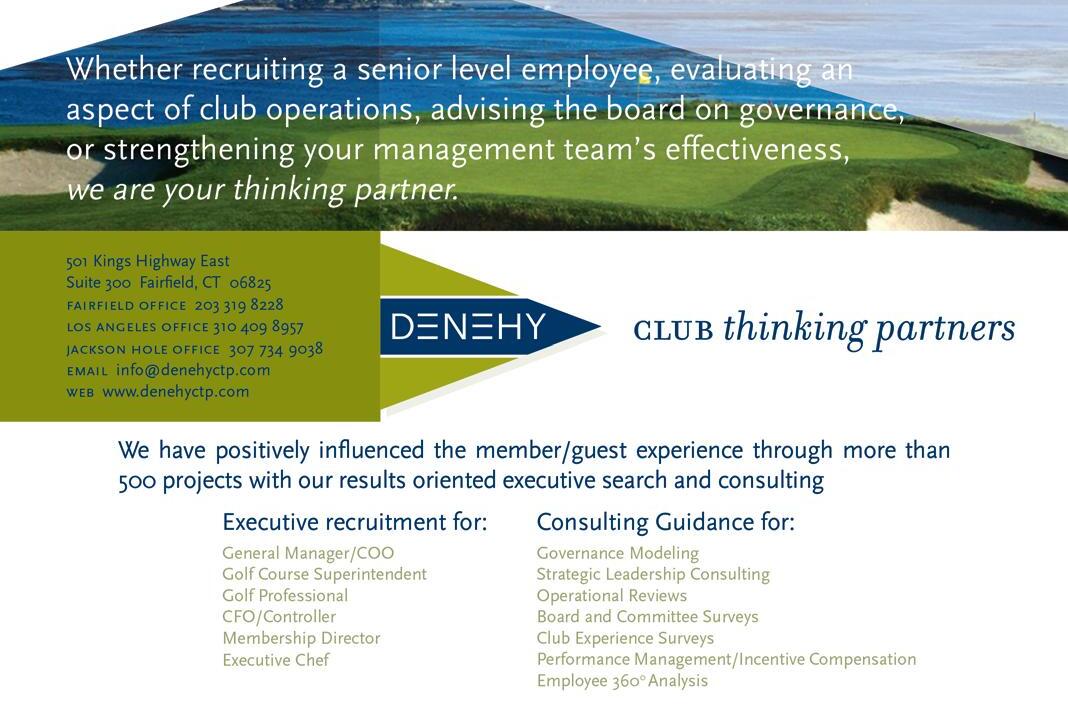

While sometimes it can be difficult to see real world impact of accounting standards, particularly, for the private club industry, there is one standard that the industry should be carefully analyzing and preparing for its implementation.
Leasing has long been a staple of club financing, particularly in relation to golf carts or golf course maintenance equipment and many of the leases have been classified as operating leases.
On February 25, 2016, the Financial Accounting Standards Board issued Accounting Standards Update (ASU) 2016-02, Leases (Topic 842), its long-awaited final standard on the accounting for leases. ASU 2016-02 was issued in three parts: (a) Section A, “Leases: Amendments to the FASB Accounting Standards Codification®,” (b) Section B, “Conforming Amendments Related to Leases: Amendments to the FASB Accounting Standards Codification®,” and (c) Section C, “Background Information and Basis for Conclusions.”

With the new standard, operating leases will be confined to history and all leases, excluding short-term leases, will require clubs to record an asset and a liability in relation to its lease payment obligations. The most significant change for lessees is the requirement under the new guidance to recognize right-of-use assets and lease liabilities for all leases not considered short-term leases.
While both lessees and lessors are affected by the new guidance, the effects on lessees are much more significant. With the new standard, operating leases will be confined to history and all leases, excluding short-term leases, will require clubs to record an asset and a liability in relation to its lease payment obligations.
The most significant change for lessees is the requirement under the new guidance to recognize right-of-use assets and lease liabilities for all leases not considered short-term leases.
By definition, a short-term lease is one in which: (a) the lease term is 12 months or less and (b) there is not an option to purchase the underlying asset that the lessee is reasonably certain to exercise.
For short-term leases, lessees may elect an accounting policy by class of underlying asset under which right-of-use assets and lease liabilities are not recognized and lease payments are generally recognized as expense over the lease term on a straight-line basis. This change will result in lessees recognizing right-of-use assets and lease liabilities for most leases currently accounted for as operating leases under the legacy lease accounting guidance.
Examples of changes in the new guidance affecting both lessees and lessors include: (a) defining initial direct costs to only include those incremental costs that would not have been incurred if the lease had not been entered into, (b) requiring related party leases to be accounted for based on their legally enforceable terms and conditions, (c) eliminating the additional requirements that must be applied today to leases involving real estate and (d) revising the circumstances under which the transfer contract in a sale-leaseback transaction should be accounted for as the sale of an asset by the seller-lessee and the purchase of an asset by the buyer-lessor. In addition, both lessees and lessors are subject to new disclosure requirements.
What should clubs think about, in addition to the accounting consequences? Arguably there are three areas that clubs should consider:
1. Bank covenants under existing debt obligations –how will the requirement to record these lease liabilities affect your club’s ability to meet existing debt covenants and related financial ratios? Clubs should be already discussing this with their lenders.
2. Capital funding requirements – many clubs have bylaw or other budgetary restrictions governing how fixed assets should be paid for. With all leases being reflected as assets on the club’s statement of financial position, will club’s now find that their capital funds are insufficient?
Clubs should consider the impact of the new standard on their capital budget methodology.
3. Changes to operating budget – Operating lease payments currently recorded as a departmental operating expense will become a principal payment in reduction of the obligation under the capital lease on the statement of financial position and interest expense in the operating statement.
The asset recorded as property and equipment will be amortized over the term of the lease or the life of the asset, whichever is shorter.
4. Benchmarking – one of the primary arguments for changing the standard was to increase comparability amongst companies.
Clubs have long struggled to properly benchmark areas of their operations, such as golf course maintenance, since some clubs had capital leases while others had leases that were treated as operating.
Clubs should be aware that the benchmark data they currently compare themselves against could change significantly.
Even though the new guidance is not first effective until 2019 for calendar-year public business entities (and certain not-for-profit entities and employee benefit plans) and 2020 for all other calendar-year entities, clubs should begin familiarizing themselves with it soon so as to better understand its financial reporting consequences. BR
Bob Salmore, director, is a member of RSM US LLP, a national professional services firm with a focused industry practice that provides accounting, tax and consulting services to hundreds of private clubs throughout the country. He can be reached at (800) 966-0428 or via email: bob.salmore@rsmus.com.


The most important weapon in your arsenal of food and beverage sales is your wine by the glass program.
I would venture there is nothing else at your club that is enjoyed by your members on a regular basis with the same earning potential.
The quick response to this argument would be, “what about booze?” While true, liquor typically has a better overall margin than wine, here are three counterpoints.
First, people tend to enjoy more than a single glass of wine during a meal – one country club pour of a martini or Manhattan will often suffice. A $12 martini or two $10 glasses of wine? I will take the extra eight dollars to the bank – you can keep your margins.
Second, red wine has been determined to have health benefits associated with it that encourages moderate daily consumption – ‘it’s for your own good,’ Mom used to say!
Third, there is an infinite amount of food and wine pairing possibilities! Now, I am a huge fan of the extremely talented mixologists who are putting together genius combinations of tastes and flavors – and the food and cocktail pairing potential is greater now than it has ever been. Yet, I am tired of waiting 20 minutes for a drink – I’ll pour you a glass of wine in less than five seconds.
There comes a time during a dining experience when a light goes off – when you have been transformed by the perfect food and wine pairing.
A paradigm shift results where you understand that food and wine are part of the same team. Wine should be thought of as a food accompaniment like a sauce or a side dish, not just a beverage.
Think of Peter Brady from the Brady Bunch – his favorite meal was “pork chops and apple sauce.” Have you ever had pork chops and an apple-y, off-dry Riesling? It’s fantastic! One you grasp this, the wonderful world of wine and cuisine pairing is taken to a whole new
level. An effective wine by the glass program makes the magic possible.
Here are some guidelines:
Start with basic varieties that everyone seems to love. Take Chardonnay, Cabernet Sauvignon and Pinot Noir, for example. Introduce two of each at different price points and from different wine regions.
Choosing Chablis and Sonoma for Chardonnay, Napa Valley and a Claret from Bordeaux for Cabernet Sauvignon, with a Pinot Noir from Russian River Valley and Oregon is a good way to introduce uniquely delicious grape varieties that speak of their place of origin.
Throw in good Chianti from Italy and a Sauvignon Blanc from New Zealand, a dry rose and some fizzy from Champagne and you can put together a delicious wine pairing with virtually anything coming out of your kitchen!
So, let the adventure begin. Start with a great cliché for food and wine pairing – “What grows together, goes together.” If the chef is running a special on quail from Sonoma on the west coast, try a Pinot Noir from Petaluma. A classic Spaghetti Bolognese? Lambrusco, baby!
Impassion your wait staff to get involved, too. When talking up a culinary special to your members, a great trick is to end it with, “Oh, by the way”, then fill in the blank: “try our Merlot with the Duck in Currant Sauce.”
Pour a two-ounce taste of the wine when the dish arrives and then walk away. More often than not, a full glass will be immediately and enthusiastically requested.
Have fun with it and remember, we get to make people happy for a living!
Life is pretty good! BR
Steven Poe is a master sommelier, beverage director at Big Canyon Country Club in Newport Beach, CA and can be reached at (949) 706-5270 or via email: spoe@bigcanyoncc.org.




There is increased awareness in the club business about recycling waste. Tennis departments produce a significant number of used cups, cardboard from pro shop merchandise, and used tennis balls from member play, ball machines and the professional’s teaching baskets.
So tennis departments have a responsibility to do their part and there are several steps that can be taken to make recycling easier and at very little cost to the club.
The first step is to replace the styrofoam cups with paper or plastic. Styrofoam is not recyclable and there are numerous sizes of paper or plastic cups with dispensers that are readily available to serve your member’s needs.
The second step is to make certain that there are recycling bins in all of the viewing areas and on all of the courts. The staff and the members will more likely be committed to recycling, if the bins are conveniently placed.
The recycling of the cardboard from the shop is easiest of all. Give the task to a specific staff member and make that person responsible for breaking it down and placing it for pickup every week.
There have been limited options for used tennis balls in the past because they cannot be processed with regular recycling methods. There are approximately 125 million tennis balls sold annually in the U.S., and it’s estimated that it takes 450 years for a tennis ball to decompose. It’s easy to understand the importance of finding solutions to the problem so they don’t end up in our landfills every year.
Finally, there is a movement to make tennis ball recycling happen, and currently two organizations take donated balls for reuse or recycling. Project Green Ball is a non-profit organization that recycles balls by grinding them up and using them for alternative recreational surfaces such as equestrian arena flooring.
ReBounces has a patented technology that restores dead balls in bulk back to their original
bounce. ReBounces will also send you a prepaid shipping label for your donated tennis balls. Both organizations are providing a great service to the industry.
Making a few investments in regular equipment upgrades with new purchases and on-going maintenance can help a club become greener. New technologies in the tennis market such as LED lighting, sub-surface irrigated clay courts, state of the art maintenance equipment and court enclosure/fencing technologies all save time, which in turn saves money in the long run by reducing operating costs.
The club’s management team should lead by example and set the tone for their area of recycling at clubs throughout the U.S.
The club business can be incredible busy and hectic at times but we all need to take the time and commit to improving our recycling efforts. We can influence the members as well as the staff with proper education on the recycling goals of the club. Working together we can improve awareness of recycling and the many benefits. We all have a responsibility to ensure our club is doing their part in recycling at every level.
We set an example by our actions; therefore, it is paramount that managers believe in what they are doing. In other words, practice what you preach. It takes teamwork to make it all come together so don’t be afraid to ask others for ideas so that they become vested in the efforts. BR
Tom McGraw is the tennis director at the Port Royal Club in Naples, Fla., which recently earned BoardRoom Distinguished Emerald Club status. He is a USPTA master professional and USPTA immediate past president.
Todd Dettor is the vice president of Fast-Dry Courts, Inc., founder/president of Tennclosure Fence Systems, LCC, and a shareholder of 10-S Tennis Supply in Pompano Beach, Fla.

A fundamental tenet, understood but too often ignored by golfers, is to not make matters worse. Bite the bullet, get out of trouble, don’t go for the miracle shot.
Perhaps Australian doctor Bing Michael Oei should have followed that strategy after he found himself expelled from the Australian Golf Club for cheating.
“In March this year, the Australian Golf Club board found Dr Oei’s cheating to be ‘unbecoming conduct’ and expelled him after a disciplinary hearing.
“This came after club members reported seeing Dr Oei handling his ball to improve his position, out of sight from his playing partners.
“It was alleged that, in July last year, he picked up his golf ball and threw it underarm three metres in an attempt to improve his position.
“Dr Oei denied that he had done anything in a dishonest fashion…
“In November, it was alleged he moved his ball one metre alongside the fairway bunker.”
Instead of taking his medicine and moving on, Dr. Oei “claimed there would be ‘serious consequences’ if he lost his Australian Golf Club membership, including ‘loss of enjoyment of club amenities’ and ‘damage to his reputation.’”
“If the club did not give his membership back, he wanted compensation for his loss.”
The club said no, and Dr. Oei carried through on his threat and sued the club. To no avail.
Now, Dr. Oei not only has the stigma of expulsion, but the publicity of an adverse court decision that recently issued, and has been widely reported, including the following:
“On Thursday, Justice John Sackar found there was no ‘legitimate basis ‘forthe courts to interfere with the club’s decision to expel Dr Oei. As Judge Sackar further held, “But when pressed further as to what his attitude to the charges was, [Dr. Oei’s] response was that he may have erred in throwing the ball rather than dropping it.”
“The board was entitled to reject the Plaintiff’s account and find reasonably that he deliberately flouted the rules again to place himself in a more advantageous position,” Justice Sackar said.
Dr Oei also tried to argue that his actions did not fall within the definitions of “unbecoming conduct” but Justice Sackar disagreed.

“It seems to me that a deliberate flouting of the rules would reasonably be in context regarded as conduct unbecoming.” BR

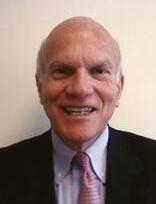
Sameness (We are alike!) versus diversity (We are different!) on a club’s management team may lead to different results for a club’s general manager.
Sameness means identical educational background, prior work experiences, political persuasion, gender, color or age. These same qualities, one or more of them, naturally lead to: 1) quicker acceptance of a new professional on the team 2) a unified purpose 3) an ease or comfort when interacting with like-minded professionals, and 4) potentially less conflict among staff members.
When everyone is the same, results are achieved faster. Sameness is an advantage at a club when a turnaround is needed in financial operations, moving from cash-poor to cashrich. It can be a plus when a club relies on referrals from successful employees as its primary recruiting strategy.
But sameness can be boring – there is no debate about the best path forward for the country club, and it may be illegal. Referralbased hiring practices alone do not include the ethnic and social diversity represented in many local labor markets.
Diversity on a management team is defined as differences represented by social status, color, education, gender or age among others. These differences are evident in the Marines with their brand name of “The Few. The Brave. The Marines.”
The Navy Seals have a signature line of “One Goal. One Team. The Seals.”
Diversity does not mean only the military or combat. Whether the Marines or the Seals, they have a common purpose and culture endorsed by a diverse group of professionals.
At a country club, a management team built on the theme of diversity will: 1) ensure the presence of many different points of view 2) rely on a willingness to tackle difficult projects, e.g., a capital campaign, a new strategy for the club, or a site plan for expanding or upgrading the campus, and 3) learn how to address and manage conflicting viewpoints.
Diversity or differences among team members will stir constructive conflict or debate as the team members deliberate about the most effective plan of action. This type of intellectual and emotional diversity should be encouraged and approved by the GM and their board of governors, as the management team sorts or prioritizes key short- and long-term actions in the club’s strategic plan, as well as the annual operating plan.
At a club, diversity of talent and points of view will work best when considering out-ofthe-ordinary creative tasks such as the key operating priorities in a strategic plan, launching a new product or service for members, expanding the physical plant and contemporary uses for new facilities.
For these three initiatives at a club there is not an obvious choice to address them effectively. It is here that a diverse management team is best positioned to tackle these tasks. From the debate among team members with diverse points of view, ideas and actions that can be implemented will emerge.
Researchers at Stanford Graduate School of Business have found that a diverse team is more effective when addressing complicated tasks that require the interdependent work of several departments. That is a compelling outcome for country clubs tackling their three-year strategic plan, launching a new service for members, etc. By definition these complicated tasks are best dealt with by a team whose membership is diverse.
At a country club sameness has its place and may succeed with a supportive culture. I favor diversity because an informed debate among team members from different backgrounds sharpens the consideration of ideas for complex club tasks and accelerates implementation of the agreed to ideas with speedy and focused actions. BR
David W. Lacey is managing director, HR Services, The Hirshorn Company. He recently completed his second board term at The Philadelphia Cricket Club. He can be reached via email: dlacey@hirshorn.com
LED Lighting can save between 50-85 percent of the lighting cost in a club, so it has become an attractive way to reduce expenses while being environmentally friendly.
However, finding the right LED lighting solution for every lighting application in your club presents an incredible challenge, as the right products are not easily found in typical purchasing channels. Another challenge is that the manufacturers don’t provide products for all the club’s applications that are the best fit for the club.
Most private club tennis facilities do not have evenly saturated light quality because they are using metal halide or other high intensity discharge products to illuminate their sports surfaces. Most have not adopted LED technology because until recently the products were unable to provide the appropriate brightness. However, now that the costs have come down and the technology has drastically improved, we are seeing adoption in the private club’s sportslighting facilities. We have evaluated numerous products and only a few have the capability to provide Class I-III USTA lighting standards. Whether direct or indirect sportslighting, the key component we find is to provide detailed before and after analysis that includes photometric studies and conformance to the USTA construction manual for sportslighting.
You may try to purchase LED on your own, but you are most likely NOT going to have a successful outcome. With high,
medium and low output options, varying brightness, beam angles and light temperatures, the bottom line is, if you’re not a professional in the LED business, you will inevitably make mistakes. The other common mistake on buying LED is going for the most inexpensive available. Most cheap LED’s we have seen have high failure rates, and many would not qualify for utility company rebates. We have also seen utility companies providing lamps for free to clubs that have the wrong light temperature and output for the private club experience, and are not compatible with sophisticated lighting control (dimming) systems. If it sounds to good to be true, it usually is. Our saying is “cheap becomes expensive” for clubs falling for some of these programs. Many have put LED’s in and taken them out when using these “cheap or free” programs.
Utilizing a professional company like SES Lighting is paramount in finding the right solution, professionally administering the rebate applications, procuring the right products, installing them correctly and servicing warranty issues. SES Lighting understands the private club business and the owners are former club managers and have put together a team of lighting specialists, engineers, designers and integrators to serve your club’s every need! BR
Nelson A. Scott, CCM, is Founding Owner and COO of SES Lighting and can be reached at NScott@seslights.com or (855) 594-4878 x703


Donald Trump is making front page news again. No, not for his politics and his race to become President of the United States. Rather, this time it is for his ownership and operation of the Trump National Golf Club in Jupiter, Florida and the club’s obligation to refund membership deposits.
Trump purchased the club, formerly a RitzCarlton branded property, in 2013 through one of his entities, Trump Golf. At the time of the purchase, the membership plan required payment of a refundable membership deposit in order to acquire a membership in the club.
Some members paid as much as $200,000 to acquire one of these refundable memberships. Members were eligible to receive a refund of their deposit at the end of 30 years or, if the membership was resigned and reissued to another member before the end of the 30 years, the resigned member would receive 80 percent of the amount paid.
The membership plan also provided for repayment of the membership deposit if a membership category was terminated. When Trump Golf acquired the club, it had approximately $30 million of membership refund liability and Trump Golf assumed this liability.
In addition to the provisions regarding refund of the membership deposits, the membership plan also allowed changes to the terms and conditions of membership. Thus, shortly after Trump Golf acquired the club, the membership offering was changed and members were invited to accept a nonrefundable membership deposit program instead of the refundable one they had originally purchased.
People who were on the resigned list were no longer permitted to use the club’s facilities as they had previously been permitted to do if they had continued to pay dues.
As a result of these changes, the resigned members brought a class-action lawsuit against Trump Golf claiming that the net effect of the changes to the membership offering was equivalent to termination of the members’ category of
membership, thereby activating the clause requiring their membership deposits to be refunded in full within 30 days.
Their claim was for breach of contract on the basis that the refunds were not paid following termination of the members’ membership category. In defense of these claims, Trump Golf argued that it was authorized by the membership documents to change the rules and no membership categories were actually terminated, thus the refund provisions had not been activated.
The trial is set for the later this year, but regardless of the outcome, the case frames an issue that is vital to the future of the club industry. Most club professionals agree that refundable membership programs are not the mainstay offering they once were.
Demographics, market pressures and infamous cases like the Bernie Madoff case have forever changed the industry, and the refundable membership model, which was previously the preferred model, is rapidly becoming a thing of the past.
The problem is non-refundable memberships generally sell for substantially less money. So, how can a club have sufficient cash flow for current operations and future capital expenditures when it has to repay high dollar refundable amounts with lower dollar non-refundable amounts now being received from new members?
As clubs strive to adjust to the new nonrefundable model, they struggle with finding a solution to this pressing problem and many, like Trump, will end up fighting over it in court.
What Trump did wrong, like those controlling many other clubs, was to unilaterally make significant changes without involvement of, and support from, the members themselves.
In contrast, some clubs have implemented a “Hero Program” to effectuate substantial reduction in the club’s refund liability without winding up immediately in court. They conscientiously examine the membership documents, commitments made to former and existing members and the
legal alternatives, and make a plan that involves the members.
It is called a hero program because the members themselves are given the information necessary to understand the options and they, individually and collectively, agree to make a sacrifice for the long term survival of the club.
Just as each club has its own particular membership documents, goals and visions, the program is different for each club, but the one essential element remains the same. Involve the members, garner their support, and work together to make changes necessary to solve the refund and redemption dilemma. BR
Michelle Tanzer, Esq. arbitrates club related disputes for the American Arbitration Association’s (AAA) national golf industry panel and authored “The Club Litigation Book: Keeping Clubs out of Court.” She is chair of the residential, resort and club section at GrayRobinson, P.A. and can be reached at (561) 866-5700 or via email: Michelle.Tanzer@Gray-Robinson.com.



My wife and I visited St. Petersburgh, Russia recently, wanting to “go deep” into Romanov history, the Russian Revolution, the siege of Leningrad, the Hermitage museum and the Kirov ballet.
We wanted a special someone, a professional guide, to provide insights and focus, a personal tutor, a “magician” who’d make “the stones speak.” My wife found a “special someone” who, she was told, is The Best – a native of the city, with multiple degrees from two universities, a knowledgeable, energized long time professional who’d recently been named guide of the year for all of Russia. Helen, we were told, would “enlarge and enrich” our experience in this most magnificent of cities.
So we hired Helen for four days and quickly discovered that Helen had The goods, that she truly was the best. While witnessing and absorbing “The Helen Experience” I began pondering why she was such a superstar guide, why her expression of service captured the essence of The Service Personality
Then, crack, I heard the thunder, was struck by lightning and saw The Why! Helen is the best because she is a TASS Master…a Teacher and a master; an Actor and a Master; a Speaker and a Master, and a Server and a Master.
Helen had TASS…a TASS Master. She enlarged and enriched our visit, and became, without knowing or trying, the template I’ll use in the future to evaluate myself, teachers, leaders, supervisors, waiters, waitresses, spouses, parents, dinner guests or guides.
Want to become a TASS Master like Helen? Want a different way of seeing and evaluating the service experience, the seminar encounter, the staff meeting or your spouse? Want a template for dissecting your next people encounter?
Learn the principles of TASS from Helen
T is for teacher: Helen was a teacher. She gave my wife and me the curiosity to seek. We’d never have gone to the Faberge “Egg Museum” if she had not suggested doing so with enthusiasm.Like every good teacher, she gave us the eyes to see the jewelry and silver-
ware in a way we’d never imagined. And, like every good teacher, she gave us the tools we needed; the books to read, the movies to view, and the people to meet, to continue our lifelong, self-guided educational journey.
Great leaders, servers and golf pros are masters of teach. And Helen is a teacher—-a master.
A is for actor: It’s one thing to know your stuff, it’s quite another to convey the stuff with Buzz. At the Faberge, Helen, like any good actor, brought her knowledge alive
Like any great actor, she knew that only 10 percent of the spoken message was about the words spoken. Necessary but not sufficient. Words by themselves are blah. Words need intonation, inflection and emphasis to resonate and these –the big three – are 30 percent of a well-spoken message. Again, necessary but not sufficient. But Helen knew that great actors focus on the remaining 60 percent of the spoken word, and that’s body language, the visual symbols needed to deliver the message with impact. She knew the eggs, she provided emphasis when describing the eggs, and she delivered the visuals needed to dramatize The Egg Experience. A great waiter, describing the day’s specials, needs to be a great actor. And Helen is an actor, a master.
S is for Speaker: Helen guided us through The Egg Palace for two hours. She held our attention. Rapt. We were her audience, attentive, engaged, enthused. And she was our speaker, a master.
Listen to Helen and you’ll know the goods a great speaker’s got. She knows the stuff she is speaking about – cold. She loves the stuff she’s speaking about, with passion. And she’s able to channel the love, and it’s the love listeners remember.
A great manager needs to be a great speaker at the next staff meeting. And Helen is a great speaker, a master.
S is for Server: Helen’s the consummate hospitality professional. She has EIIP –Empathy for our needs (“After touring with you for two days, I thought you might like to visit The Egg Palace.”); able to Inspire us about the eggs we saw; a fountain of Information about the Palace –The Eggs,
the history surrounding The Eggs and the dates when each was made and by whom, and, like any good server, she is able to Provide the goods needed to make the experience happen.
But Helen had more. She lives The Principles of Service.
Principle One: Deliver happiness to those being served. And she inspires Big Happy.
Principle Two: Give dignity to those you serve. We knew nothing about The Egg Palace yet she made us feel “knowing” when she could have made us feel dumb.
Principle Three: Anticipate the needs of those you serve. Helen knew we hated crowds and lines and she got us in early to avoid both.
Principle Four: Clean thinking and clean priorities. Helen knew we’d have questions, she encouraged those questions and answered each question cleanly. She always made us her first priority. She had clean priorities, people (Us!!!) always came before “stuff”.
Principle Five: Deliver The Stuff. Helen knew what was needed to make The Egg Palace experience work – the right rooms in the right order, the right eggs in the right order, the right “historical elaboration” in the right order.
Principle Six: Be a presence. Helen was at our elbow, physically present, all the time. And mentally present, focused on us.
And, Principle 7: She saw everything and when something needed doing, she did it. Weren’t wearing the plastic booties to cover your shoes? She noticed and made us
wear ‘em. A great front desk receptionist needs to have service soul. And Helen was a great server, a master.
Everyone wants a Great Guide in their life – a spouse, a teacher, a supervisor, a manager, a board member, a professional coach, a wine steward – to provide insights and focus, a personal tutor, a “magician” who’s able to make “the stones speak.”
Helen of St. Petersburgh was and is all of those things. The Lens through which my wife and I saw The Russian Experience. She enlarged and enriched our journey. When we visited The Egg Palace, Helen delivered TASS without even knowing TASS was being delivered. She taught us The Principles of TASS without even knowing TASS was being taught. Helen wrote the Book of TASS that every manager, spouse, server and golf pro needs to read. Study the TASS template. Live TASS. Expect TASS from the waiters you meet, the leaders you speak to and the friends you keep. And enjoy the journey… BR
Gregg Patterson served the Beach Club of Santa Monica as its general manager for 33 years before retiring earlier this year. He’s also one recipient of Boardroom magazine’s Award of Dedication for 2015, for all his timeless, energetic and dedicated service to the private club industry. Patterson is president of Tribal Magic and can be reached via email: GJPAir@aol.com


As chair of the professional development committee for the Club Managers Association of America, tell us what is new in this arena.
Recently, our membership approved combining the Club Management Institute (CMI) and the certification Committees into the Professional Development Committee in order to reduce the duplication of efforts.
Our association’s educational focus will be under the direction of one committee – Professional Development –and our efforts will be concentrated on starting to implement the professional development’s portion of the association’s recently adopted strategic plan.
We continue to review and revise our Business Management Institute (BMI) programs in order to ensure that we are meeting the challenges and knowledge requirements of our ever-changing industry. The committee’s education program for the 2017 World Conference in Orlando includes newly formatted pre-conference ses-
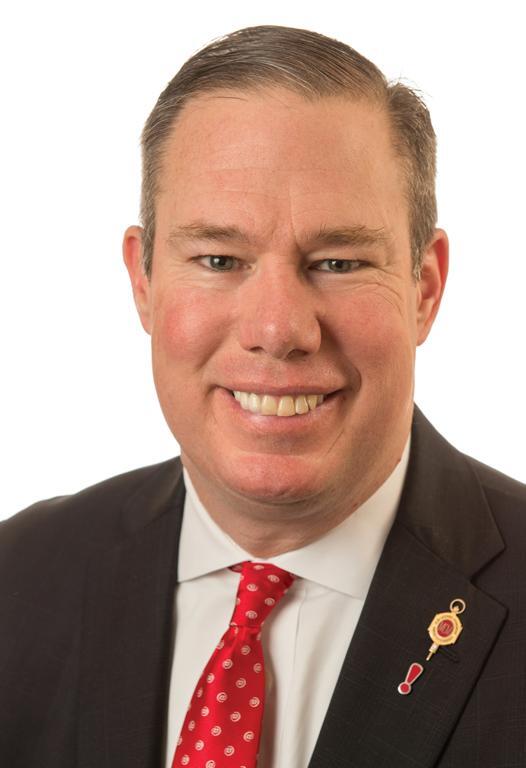
sions, inspirational keynote speakers, breakout sessions, and diversified/experience-level offerings such as track education, yacht and generational educational sessions.
Additionally, the national office will be hosting the MidManagement Conference in Washington, DC, September 24-27. This will allow the conference to utilize the association’s professional resources to ensure that we are offering the highest quality experience to those managers in attendance. In the future, the committee plans to review the requirements needed to qualify for the Certified Club Manager (CCM exam) to ensure that they are in line with the industry standards and expectations.
It is an honor and a privilege to sit on the board of directors and as chairman of the professional development committee as we work to ensure that our association is providing the most relevant and applicable level of education to our membership.
What makes the education offered by CMAA different from what students learn in hospitality school?
Unlike the broader based education students learn through hospitality school, our association’s education is club specific. Instead of learning in a traditional classroom setting, our members have the opportunity to gain education at local, regional, national, and international sessions as well as participate in online sessions.
The association also diversifies our educational offerings by basing them on the large variety of experience levels of those managers attending the sessions. With multiple dates offered for BMIs, a large selection of local chapter education sessions and various conferences and sessions held throughout the country during the year, our members have ample opportunities to continue their professional development and enhance their managerial skill set.
How is CMAA working to educate boards and managers on club governance issues?
In a recent CMAA survey, our members identified club governance as one of their biggest challenges. In order to address this concept, for the past two years at World Conference the association offered a pre-conference presidential track where specific best-industry practices were reviewed and discussed. Both managers and their club presidents were invited to participate in this session where they had an opportunity to interact and share with fellow managers and then experience other facets of the conference including accessing the Club Business Expo.
In 2016, our association has expanded this opportunity for cooperative governance/leadership education and best practices by debuting six regional one-day seminars for a manager and their president.
The MCM (Master Club Manager) program began in 1990 as a way to recognize a manager’s significant, long lasting contributions to the club industry not only to their club but to their professional and community as well. To earn the MCM designation, a manager works closely with members of the MCM Academic Council, industry experts, current managers and collegiate faculty to complete a monograph.
The MCM Monograph, written by the MCM candidate, covers a topic that they believe is important to the private club industry. I chose Integrated Team Management as my monograph topic and successfully defended my paper to the MCM Academic Council in 2012.
I earned the MCM designation at the New Orleans World Conference in 2012 and joined the ranks of only 19 other
from BoardRoom Basics |18
In our experience in the field, the expectation for high visibility of the GM and their team continues to be one the most prominent issues leading to termination of managers. I have had dozens of general managers that have told me over the last couple of years how the need for work/life balance for their managers and key department heads has only worsened their ability to get down time. I implore them to educate their boards. Be clear that you know when to work and be seen. Talk about it with your president. It should be understood that to be truly effective you cannot work around the clock, nor do you need to, if you develop your people and have proper operating procedures and processes in place – starting with departmental vision and mission statements.
from Shining Lights |32
a variety of food and beverage supplies from The Bath & Tennis Club, Palm Beach.
The clean-up of the destruction and rebuilding the lives and homes is a major undertaken given that over 200 homes were completed destroyed. Another 180 homes were damaged by the receding flood waters.
Kevin and I assisted with unloading all of the supplies of the second truck at the church, along with other volunteers. The heartfelt appreciation and tears were flowing from all of the church volunteers and victims arriving for free supplies to help them in their cleaning and recovery efforts.
Our final phase in this relief effort is to donate the remaining funds to one suitable charity fund in White
club managers who have earned this designation. It is a long process but through the work I was required to complete, I was able to articulate a management philosophy that I believe will make clubs and their managers successful. I look forward to assisting future MCM candidates in their journey to this designation.
The future for the private club industry is bright. As an association, we need to continue to keep ourselves and our offerings relevant. We are in the member experience business and in order to have a successful operation, the clubs needs to be led by well-trained Certified Club Managers.
CMAA is the organization with the resources to ensure these managers are properly prepared and educated to create the ultimate members’ experiences at their respective clubs. BR
Mark Bado, MCM, CCE, chair of the CMAA Professional Development Committee and general manager/COO of the Kansas City Country Club, Mission Hills, KS
Remember the “Hey, what did I miss” line works just as well when you’re walking back into the club. The strong team and operation you have built and board you have educated will support you with the answer, just like your family does.
Hospitality is defined as kindness, welcoming or generous. So now I ask, if hospitality is a field of work and a way of life, shouldn’t we extend it to ourselves and our loved ones as well? BR
Tom Wallace is a search executive and consultant with Kopplin Kuebler & Wallace, a consulting firm providing executive search, strategic planning and data analysis services to the private club and hospitality industries. The company has offices in Scottsdale, Jupiter, Atlanta, Denver, Cleveland, Washington D.C. and Naples. Tom can be contacted at (412) 670-2021 and at tom@kopplinandkuebler.com.
Sulphur Springs that will direct 100 percent of the funds to affected individuals and their families to help rebuild their homes and lives.
Kevin and I are working with the town and community leaders to identify a charity group that provides 100 percent confidence in their pledge to deliver on our collective goals and objectives. The town and community leaders have conveyed their genuine commitment to do this in a transparent method and want to express their appreciation to the Florida Chapter of the CMAA. BR
Craig D. Martin, CCM, is chief operating officer and general manager, St. Andrews Country Club of Boca Raton, Boca Raton, FL


BY MICHAEL CRANDAL

June 20, 1936 – June 27, 2016
John Sibbald left a resounding positive impact on the private club industry. The ripple effects are more profound than many may be fully aware − yet are still felt to this very today.
Sibbald’s early career revolved around the human resources industry with ever increasing positions of responsibility in the corporate world.
At the age of 39, he opened his own firm, John Sibbald Associates, and quickly began earning clients like Ralston Purina, Monsanto, Anheuser-Busch, Barry Wehmiller and Johnson Wax to identify and recruit top executive talent.
A shift in the focus of JSA started when Sam Johnson, president of Johnson Wax, said to Sibbald, “Being president of this company is my easy job. My tough job is being president of the Racine Country Club. Could you find a great GM for me?”
Sibbald sensed a need in private clubs that could be addressed by professional executive search expertise that the corporate world already embraced. Up until this time, retaining professional expertise in hiring management was rare in the private club industry. Board members simply did this in their spare time.
Written GM position descriptions and annual reviews were not routine and performance expectations were seldom clearly defined. Club managers only occasionally attended board meetings and then just to answer a few questions before being excused. The golf professional and superintendent routinely reported to committee chairs, employment contracts were a rarity, severance agreements nonexistent, and the average tenure for a GM hovered around two years.
Sibbald set out to remedy the situation, and the focus of JSA ultimately shifted exclusively to the needs of private clubs.
Over a 30-year span, JSA placed 1,500+ club managers and laid the foundation for those in the industry today. His work and vision revolutionized the private club industry.
JSA introduced “Retained Executive Search” to the private club industry While certainly not inventing executive search, Sibbald definitely pioneered and transferred it successfully from the corporate world to private clubs.
The longevity of GM’s began to rise and compensation packages grew exponentially than would have otherwise happened, if at all.
Sib bald personally championed specific, written GM position descriptions that included an annual performance review and identifying the criteria and formal written job offers and employment agreements spelling out compensation and severance protection were introduced.
Sibbald made it all happen. Indeed – John Sibbald had a tremendously positive impact on private club management, solid leadership and effective board governance.
JSA CONCEIVED AND FOUNDED THE PLATINUM CLUBS OF AMERICA
JSA PUBLISHED THE PRIVATE CLUB LEADERS FORUM
JSA CREATED THE BOARD OF DIRECTOR’S SELF AUDIT
Oh, and one more thing, just in case you’re wondering. The letters after our author’s name Michael Crandal, CNG ~ stand for: Certified Nice Guy. Self-certified, by the way. But, a nice guy nonetheless. He and his wife, enjoy each other and their home together in the Buckhead area of Atlanta, GA. www.linkedin.com/in/michaelcrandal
“Many clubs are attempting to circumvent this with a variety of impromptu solutions, which are resulting to disputes, some of which are ending up in court. Alternatively, some clubs are addressing the refund and redemption issue proactively, by getting guidance from legal and financial advisors on how to develop a plan (I personally call it the “HERO Program”) that enables the club to reorganize the repayment obligations in a way that is both consistent with the legal requirements and also reduces the gap between what amounts are coming in and what amounts are going out.
“It is imperative that the gap be closed because no club (or any business) can be viable for any extended period of time if they are in a negative cash position for every sale. These funds are necessary not only for current operations but for capital improvements as well.
“Short-term focus is an issue,” outlined industry consultant Gordon Welch in referring to a club’s governance.
“Some boards allow the daily operation of the club to be their focus instead of the long-term strategy. Boards need to focus on long-term strategy or the strategic plan. Strategy is like the front wheels of a bicycle and the club’s culture and daily operations are like the chain, cogs and back wheel,” he added, by drawing an analogy. “The board will win the race only when they allow the two halves to work together.
However, the board needs to steer the “bike” and keep an eye where they (the board and club) are going.
“Board leadership is an honor and an obligation once you climb the ladder to the executive committee. While it is not as widespread as in the past, many club presidents have the desire to leave their ‘mark’ on the club, whether it is a new bunker, white sand in the bunkers, a renovation of some kind, many presidents and their spouses desire some kind of memorial,” he expressed.
Welch also see ‘inertia,’ as a major drawback for boards.
“Boards have a tendency to wait… to “wait” and see what happens with an issue rather than take action on it. Many times board members do not want to make the decision or make friends angry because of their decision. Being on the board is not always a fun thing to do. Many tough decisions are made and in many cases the sooner the better.
“When it comes to their fiduciary duty, boards must act fast and make necessary changes,” Welch added.
“Being on the board of a non-profit corporation means that each director has a fiduciary duty to the club and those are generally the duties of good faith, loyalty and obedience,” stated Robyn Stowell, a partner in the law firm, Sherman & Howard in Scottsdale, AZ.
“Directors should insist that the club follow its bylaws or amend them, but refuse to allow the club to continue to operate in a manner that violates its documents.
Furthermore, any director who puts his friends’ desires above what is best for the club (or sees his fellow director
doing so) should stop and consider the consequences of breaching that duty.”
Stowell also raises a ‘touchy’ subject – booze- that’s been raised at a number or clubs around the country.
“Board meetings should be conducted and completed before alcohol is served,” Stowell explained, in stating that many clubs are not using best practices for board meetings. Alcohol served at board meetings can raise liability issues, it shows a lack of consideration for those who do not imbibe, and it certainly establishes a tone of decision making for the board.
“There is no reason board meetings should consistently exceed two hours. Excessive length means they are: (1) not availing themselves of tools (such as the consent agenda) or (2) not managing their committees (such as live reports that should have been reduced to writing and included in the consent agenda) l, or (3) allowing bad behavior (such as the director who opens the board packet for the first time AT the meeting!) or (4) failing to follow other best practices that allow efficient board operations,” Stowell stressed.
Clubs are operating as businesses and undoubtedly there’s been a growth in the professionalism and training of professional staff. It’s difficult to say the same for boards. Board members are part time volunteers, who while they may mean well, often have little understanding

about the operation of a club, and the parameters of responsibility, behavior and limits of power.
Often there’s a lack of clarity of roles for both the board and its individual members. The board sees itself, and unconsciously acts, as the management of the club. Not good!
No question, many of these difficulties, our contributors agree comes from education…or a lack of it, for board executive, members and committee members.
“Education, education, education. Board members must be educated properly,” Welch stressed.
“In addition, the general manager should be on the selection committee to weed-out potential board members with a grudge or a specific agenda. The board needs to collaborate on many issues and while disagreement is good, harmony in the boardroom is better.
“Boards must have a thorough knowledge of the club and some historical particulars, and board members have a role to accomplish and need specific training for their roles.”
“The good news is that there is a simple protocol called ‘the new board member orientation process’ that every general manager/CE should engage in when on-boarding newly elected board members,” stressed Kopplin. “That should be the ‘starting point’ for the education of new board and committee members.

“An additional tactic is to develop a ‘responsibility matrix’, which outlines every governance/management issue in the club and who is accountable for each. Putting this in writing provides a very clear road map for where the responsibility lies within every operational area of the club.
“One president told me, ‘there is no school for club presidents.’ His point is that board members and club officers learn their duties either through osmosis, watching what other directors have done, or by bringing their executive level experience to this volunteer position and being included in a board orientation process.
“He was a strong advocate of board members attending workshops and seminars on club management so that they would clearly understand their role and how it relates to the general manager,” Kopplin added.
“Board orientation, conducted properly, helps get the new board (and returning board members) up to speed, on the same page, and fully aware of what is and what is NOT their responsibility,” Stowell stated.
“Without an excellent orientation, the board can stumble forward dealing with whatever pops up in their line of vision rather than executing a clear planned path to their clear planned goals.”
This is a major reason why a board orientation each and every year, with an outside facilitator, is so vital…so that the club’s general manager and staff can provide vital information about the club’s daily operations, strengths, weaknesses, challenges and opportunities. It’ll help the board make diligent, insightful policy decisions during a term of office.
Boards must fully understand the club’s culture, its core values, the club’s mission and vision, and longrange strategic plan, and what that long-range plan means – a continuing commitment from the club’s board. Board members must be leaders, not interventionists, or second guessers.
Board members should arrive at meetings agendas read well, and ready to throw in their thoughts and opinions on often complex issues, rather than turning board meetings into a waste of time.
Knowledge is vital for decision making because a lack of knowledge of the issues can imperil not only the board’s decision making process, but also the long term future of not only the club, but also the club’s top management and board.
Equally so, it’s vital that the general manager, the club’s daily operational leader, fully prepare the board with background reports, research documents and current information required for diligent, incisive decision making.
What’s the impetus for change for the betterment of a private club and its members? Sometimes it begins with people, sometimes with process, but let’s start with people and communication, communication, communication.
Communication often and with many. Don’t limit your actions to formal meetings, but use your personal net-
works. If as GM you need help, call your board members. Pick their brains, especially those who have particular knowledge of certain areas such as human resources, or strategic planning. These people, as advisors, are valuable resources, so use them.
“Change can begin today. You need to plant seeds,” injected Gordon Welch.
“Make recommendations that need to begin in the next few years. Rational consensus building. Implementation of your strategy is the first place to begin. Do not let your strategic plan sit in a file never to be seen again. Use the strategic plan in your committee meetings to give direction and keep direction. Plant seeds with committee members so when they move up to the board level they can see your vision and the vision of the club.”
So how do boards avoid mistakes and engender solutions? Board members must separate personal agendas from that of their club…their strategic plan and the club’s daily operations. They must think like board members, for the public good.
Directors, as explained by Robyn Stowell, need to understand their fiduciary duties…that they act with the duties of good faith, due care and loyalty. Directors accept the potential liability for failing to fulfill those duties. It is not acceptable for boards to rubber stamp committee or staff recommendations or as Gordon Welch says, ‘wait and see what happens before making a decision.’ Sometimes boards have tough decision to make and make them they must.
Micromanaging is a scourge, and a board that demands and indeed insists making direct demands of staff members who work in daily operations and who report to a club’s general manager have crossed the line. It’s unacceptable in today’s private club governance. And while a private club’s isn’t Las Vegas…what happens in the boardroom, stays in the boardroom. There’s no latitude for-after meeting grumble sessions with malcontents in the men’s grille.
Club boards should act like responsible corporate boards: set policy and monitor performance and financial operations. Successful boards are the result of a true team effort of skilled management and dedicated members working toward common goals with the board creating a positive atmosphere encouraging management at all levels to be productive and focused.
Continuity is also vitally important. Managers cite two ingredients of smooth relationships between boards and staff. First is continuity of leadership, both volunteer and paid. Frequent turnover in either group hinders progress and disrupts the flow of operation. A stable work environment for professionals and a staggered rotation for board members helps assure continuity while minimizing disruptions in policy and performance.
Select your board members with care…directors who are going to attend meetings, who govern using their independent
judgment, and who offer real oversight of the club’s operations and are willing to accept their fiduciary responsibilities. Also I’ve noticed that many boards are not addressing foreseeable scenarios. And addressing and understanding these scenarios is one way for boards to avoid mistakes and find solutions
During the board orientation (which every club should have annually), the GM/COO and department heads should update the board on major issues that might affect the club. This includes future water and utility issues, equipment, new staffing laws, such as minimum wage, environmental issues and membership issues, to mention a few.
For example, take the minimum wage and potential increases. This could add 25 percent to 50 percent increase in wages since everyone is going to expect raise, which ultimately has major effect on the club’s budgets and financial programs. For a board to be effective, avoid mistakes, I believe the board must be presented with facts and projected issues. Only then can a club’s board look for solutions leading to a stronger, better member experience.
At least, that’s the way I see it! BR
JohnG. Fornaro, publisher
If you have comments on this article or suggestions for other topics, please contact John Fornaro at (949) 376-8889 or via email: johnf@apcd.com


It comes up in discussions with governance, interns, at department manager meetings and even club staff members who look for it as a guiding light.
But where’s the light? Where do you determine best practices for your club?
This term in our industry, best practices is a buzz term right now, but does it have substance? I think in the top clubs, culture dictates that mostly. And most of YOU can write your own for your own businesses but does that apply to private clubs!
When we look for best practices in a tangible, practical sense - a standard of our industry - where do we turn? Is there a superior model of these in our industry, emblazoned on a wall somewhere, or written in text books at CMAA?
What are your thoughts on where one should turn to decide what best practices are best for private clubs? A favorite education program? An article or a consultant’s proclamation? I’m curious... Are you? I asked the question of a group of industry leaders. Here’s are some of their responses:
One GM had some favorite practices: Membership and activities director – The Club’s Pied Piper / Social Butterfly. Much less about membership recruitment and all about membership retention.
The person that knows every name of every adult and child and can make countless phone calls and send countless emails to drive usage through the roof. Best position I ever created.
Walking the golf course with the GM, superintendent and golf professional. Originally intended to be a monthly course audit, it has morphed into a key relationship builder between the three of them that has no boundaries. No topic is off base and it is free speak the entire way around. It is also a highly visible way to “fly the flag” in front of the membership.
Another GM wasn’t so detailed but really hit point:
It would be too easy to have one Guiding Light to turn to for all the answers. Like the universe, there are countless points of light in our world of clubs to look to for ideas and answers.
What works well for one may not work for the next. CMAA has been so very important to develop what best practices made sense for the clubs. Conferences, BMIs, chapter meetings, webinars, and club visits all offer points of light on which to draw. The (networking) in the industry and through CMAA collectively provide (a) magical Guiding Light
And yet another manager had a more practical outlook:
Best practices, I have found, to be more of what meets the eye. Meaning what may be best practice to you could be absurd for me in the detail. However, I do think a best practice procedure, the bones, the process is probably most useful to everyone so that each club can mold the detail into what they believe to be useful for them by using the process, which may be best practice. CMAA, NCA, Global Golf who feeds both CMAA and NCA – are the best resources for best practice.
From someone who visits great and not so great clubs (you learn a lot from both) on a daily basis, Dick Kopplin from Kopplin Kuebler & Wallace was kind enough to throw in his two cents and add ideas from his board dynamics presentation:
Best practices (are) being used in what we call “model clubs” around the country. They get it! In those clubs, “Managers manage, directors direct, and members enjoy.” That has been my mantra for 20 years and it still holds true. Now how do you get there?
They get their governance and organizational health right! Managers manage, directors direct, members enjoy!
Five strategies:
1) Clearly define the roles and responsibilities of board and committee members; use an activity/decision chart defining these roles and responsibilities
2) Lead/direct the club with action plans
3) Have effective new board and committee member orientations
4) “Magic” of the mission statement and supporting goals
5) Setting the standards/norms and expectations
In addition, board recruiting is an important best practice. Simply put, no one should be proposed for the board who you wouldn’t want to one day be president of the club.
Finally, most of the highest performing clubs we’ve seen do not allow not on my watch mentality to prevail. Most times, it’s simply pushing a difficult issue to someone else’s watch!
So here’s my top 10:
• Strategic planning process
• Proactive financial reporting
• Right Human Resource practices
• Employee centric compensation
• Mindful nomination processes for board members
• Written SOPs
• GM/COO concept
• Approved marketing protocol
• Active committees
• Engaged management
There you have it. Is it about what you thought? Would you run your business this way or would you have other thoughts?
Email me any ideas for I am forever searching for best practices to help us all Lead ON! br
Special Thanks to Eric J. Dietz, CCM, CCE, PGA, general manager/COO, Interlachen Country Club; Gregory P. Wolf, CCM, CCE, general manager, Scioto Country Club; Richard W. Naumann, CCM, CCE, general manager, Aronimink Golf Club; Michael S. Wheeler, MCM, CCE, chief operating officer & GM, Cherokee Town and Country Club; Dick Kopplin, Kopplin Kuebler & Wallace, and my friend Gregg Patterson, formerly general manager at The Beach Club of Santa Monica, but now riding the countryside!
Christopher Boettcher, proudly a CCM and CCE, is the GM/COO at Burlingame Country Club near San Francisco, CA and a regular contributor to BoardRoom magazine. He can be reached at chris@boettcher.com


In the last few years, I’ve personally visited hundreds of private clubs and interviewed thousands of general manager, clubhouse managers, chefs, fitness & wellness directors, controllers and human resource managers.
The most common thread among the clubs is their interest in delivering a “farm-to-table” experience to the members and staff.
It’s a growing movement sweeping the nation, and here are five things you can do today to improve the member experience and attract and retain members with a farm-to-table program.
The phrase “farm-to-table” is a buzzword referring to food made with locally sourced ingredients. At the turn of the 20th century, most of the food that Americans ate came from within 50 miles of where they lived. However, as Americans began moving away from rural areas and flocking to cities, many local food sources disappeared.
But we do know local food is not only healthier and tastier, it’s also better for the environment because fewer transport miles equal fewer transmissions. According to a study conducted by the Leopold Center for Sustainable Agriculture at Iowa State University, food travels 1,500 miles on average from farm to customer while locally sourced food travels an average of 44.6 miles. The same study found that the conventional food distribution system uses four to 17 times more fuel and emits five to 17 times more CO2 than local and regional systems.
Farm-to-table restaurants have existed for decades, but it was not until about 10 years ago, that the “locavore movement” began to really take off. Initially, farm-to-table restaurants began in progressive cities like Boulder, Colorado, Seattle, Washington and Berkeley, California, but today they can be found everywhere from Austin to Anchorage.
Many private clubs have adopted a farm-totable philosophy that features healthy, fresh, organic and locally grown food to compete with restaurants “outside the gates.”
Fruits and vegetables that have to be shipped long distances are often picked before they have a chance to fully ripen and absorb nutrients from their surroundings. Because local food doesn’t have to travel long distances, it’s grown in order
to taste better and be healthier rather than resilient for long travel. The farm-to-table movement helps local economies by supporting small farmers – a dying breed.
According to the National Restaurant Association, the top 10 food trends for 2016 include:
1. Locally sourced meats and seafood
2. Chef-driven fast casual concepts
3. Locally grown produce
4. Hyper-local sourcing
5. Natural ingredients/minimally processed foods
6. Environmental sustainability
7. Healthful kid’s menus
8. New cuts of meats
9. Sustainable seafood
10. House-made artesian ice cream
It is pretty clear from the trends that consumers want to know where their food comes from and as a club we need to look closely at how we can adapt to the trends.
Here are five things you can do today to create a farm-to-table experience that will improve the members experience, attract new members and help retain existing members.
1. Contact local farmers and buy seasonal produce direct.
2. Contact local hydroponic growers and custom order ingredients to better plan menus in advance.
3. Communicate where the club is sourcing local ingredients - in the newsletter, on the website, in the member emails, on the menus, on the mobile app, on social media sites and information inserted in the membership packet.
4. Educate the servers as to the sources of food along with the nutritional benefits. Members appreciate where their food comes from and knowledgeable servers that share these insights will help to improve the member experience.
5. Contact your local media to see if your story is newsworthy. Earned media is a great way to get “picked-up” nationally, which for many clubs drives new membership interest. br
Rick Ladendorf is the president of Prevo Health Solutions, a wellness solutions provider and Executive Producer of the AMERICA’S HEALTHIEST CLUB© wellness rating program. Contact Rick Ladendorf at (949) 933-5470 or rladendorf@prevohealth.com
Nearly 70% of all customer data breaches are enabled by innocent employees who are duped into providing access to the company’s computer systems.
Your club is no exception. Your members are affluent and influential – prime targets for hackers and identity thieves.
InteProIQ trains your employees to recognize and avoid a myriad of ploys used to gain access to sensitive member data.
Slam the door on the cyber thieves with InteProIQ’s outstanding Private Clubs 360 training program. Your members will be glad you did!
FOR MORE INFORMATION CONTACT BILL BOOTHE, BBOOTHE@BOOTHEGROUP.COM HTTPS://PRIVATECLUBS360.INTEPROIQ.COM




















Maxine DuVal, President/CEO





















Addison Law Firm
14901 Quorum Drive, Ste. 650
Dallas, TX 75254
Tel: (972) 960-8677 Fax: (972) 960-7719
Website: www.addisonlaw.com
Email: clublaw@addisonlaw.com
Contact: Randolph Addison, president
Club Advisory Services
Club Consultants LLC
5121 Castello Drive, Suite 1
Naples, FL 34103
Tel: (239) 643-7800 Fax: (239) 643-7803
Website: www.clubconsultants.com
Contact: Bill Wernersback, sr. mng. dir.
Club Neckties, Scarves, Emblems
Stratton-Crooke Enterprises Inc.
P. O. Box 215-H
Scarsdale, NY 10583
Tel: (800) 732-9719 Fax: (914) 725-5196
Website: www.strattoncrooke.com
Email: StrattonCrooke@aol.com
Contact: Nancy & Jim Crooke
Club Services
HFTP
11709 Boulder Lane, STE 110
Austin, TX 78726-1832
Tel: (512) 249-5333 Fax: (512) 249-1533
Website: www.hftp.org
Email: Laura.Huffman@hftp.org
Contact: Laura Huffman
Clubhouse Design
Chambers
1800 Washington Blvd., Suite 111 Baltimore, MD 21230
Tel: (410) 727-4535 Fax: (410) 727-6982
Website: www.chambersusa.com
Email: jsnellinger@chambersusa.com
Contact: John R. Snellinger
Peacock + Lewis Architects
1295 US Highway One North Palm Beach, FL 33408
Tel: (561) 626-9704 Fax: (561) 626-9719
Website: www.peacocklewis.com
Email: Brian@peacocklewis.com
Contact: Brian Idle
Clubhouse Architect
Judd Brown Designs
700 School Street
Pawtucket, RI (401) 721-0977
Contact: Peter Cafaro
H. Anne Blakely Sciarrone Architecture
P.O. Box 357
Decatur, GA 30031 (678) 632-2663
Contact: Anne Sciarrone
Clubhouse Furniture
Eustis Chair
P.O. Box 842
Ashburnham, MA 01430
Tel: (978) 827-3103 Fax: (978) 827-3040
Web site: www.eustischair.com
E-Mail: fred@eustischair.com
Contact: Fred Eustis
Gasser Chairs
4136 Logan Way
Youngstown, OH 44505
Tel: (330) 759-2234 Fax: (330) 759-9844
Web site: www.gasserchair.com
Email: ksmith@gasserchair.com
Contact: Kevin Smith
Consulting
Clubwise Consulting
3507 Dunlin Shore Court Norcross, GA 30092 (770) 248-1047
Contact: Jerry McCoy
Email: Cmaamcm@msn.com
Denehy Club Thinking Partners
501 Kings Highway East 06825 (203) 319 8228
Website: www.denehyctp.com
Contact: Dan Denehy
McMahon Group
670 Mason Ridge Center Drive , Suite 220
St. Louis, MO 63141
Tel: (800) 365-2498
Website: www.mcmahongroup.com
E-Mail: info@mcmahongroup.com
Course Maintenance
International Golf Maintenance, Inc. (IGM) 8390
Champions Gate Blvd #200 Champions Gate, FL 33896
Tel: (800) 413-5500 FAX: (407)589-7223
Website: www.igminc.net
Email: gregp@igminc.net
Contact: Greg A. Plotner CGCS, EVP
Executive Search Firm
Kopplin Kuebler & Wallace
Southwest Office
7349 Via Paseo Del Sur, Ste. 202 Scottsdale, AZ 85258
Tel: (480) 443-9102 Fax: (480) 443-9642
Website: www.kkandw.com
Email: dick@kkandw.com
Contact: Dick Kopplin, partner
Kopplin Kuebler & Wallace
East Coast Office
132 Tulip Tree Court Jupiter, FL 33458
Tel/Fax: (561) 747-5213
Cell: (407) 864-6798
Website: www.kkandw.com
Email: kurt@kkandw.com
Contact: Kurt Kubler, CCM, partner
Kopplin Kuebler & Wallace
Cleveland Office
20373 Scott Drive
Cleveland, OH 44149
Tel/Fax: (440) 783-1268
Cell: (412) 670-2021
Website: www.kkandw.com
Email: tom@kkandw.com
Contact: Tom B. Wallace III, CCM, partner
Food & Beverage Software
Culinary Software Services
1900 Folsom Street #210 Boulder, CO 80302
(303) 447-3334
FOOD-TRAK®/System Concepts, Inc.
15900 N. 78th Street
Scottsdale, AZ 85260
Tel: (480) 951-8011 x 8026
Fax: 480-951-2807
Email: nancys@foodtrak.com
Website: www.foodtrak.com
Contact: Nancy Shina, director of marketing
C2 Limited Design Associates
95 Reef Road
Fairfield, Connecticut 06824
Tel: (203) 259-2555 Fax: (203) 259-2565
Website: www.c2limited.com
Email: studio@c2limited.com
Contact: Craig J. Smith
Ferry, Hayes & Allen Designers, Inc.
1100 Spring Street, Suite 600 Atlanta, GA 30309
Tel: (404) 874-4411 Fax: (404) 874-1099
Website: www.fhadesigners.com
Email: jbarret@fhadesigners.com
Contact: Jeff Barrett, executive vice president
HINT |Harris Interiors
49B Lenox Pointe
Atlanta, GA 30324
Tel: (404) 403-2931
Website: www.hintatlanta.com
Email: kelley@hintatlanta.com
Image Design, Inc.
3330 Cumberland Blvd.
Atlanta, GA 30339
Tel: (770) 952-7171 Fax: (770) 933-9093
Website: www.imagedesign.com
Email: mfleming@imagedesign.com
History
Private Club Historical
1100 South Coast Highway, Suite 309 Laguna Beach, CA 92651
Tel: (949) 497-6543
Website: www.privateclubhistorical.com
E-Mail: Tom@privateclubhistorical.com
Contact: Tom Neill
Kitchen & Banquet
Spring USA
127 Ambassador Drive #147 Naperville, IL 60540 (630) 527-8600
Website: www.springusa.com
Locker Room Suppliers
Sports Solutions, Inc. 2536 Manana Drive
Dallas, TX 75220
Tel: (800) 969-8008 Fax: (214) 351-2609
Website: www.sportssolutionsinc.com
Email: sales@sportssolutionsinc.com
Contact: Laurie Schmidt
Lockers
Salsbury Industries - Lockers.com 1010 East 62nd Street
Los Angeles, CA 90001
Tel: (800) LOCKERS Fax: (800) 562-5399
Website: www.Lockers.com
Email: Salsbury@Lockers.com
Outdoor Furniture
Bambrella
6464 East Rogers Circle
Boca Raton, FL 33487
Tel: (561) 288-8655
Website: www.Bambrella.com
E-Mail: info@Bambrella.com
Xhibtz Contract Furnishing
11071 Indian Lake Circle
Boynton Beach, FL 33437
Tel: (954) 614-1505
Fax: (888) 880-9124
Website: www.xhibtz.com
Email: xhibtz1@bellsouth.net
Purchasing Group
Essensa
555 West 57th St., 12th Floor
New York, NY 10019
Tel: (866) 430-5330
Website: www.Essensa.org
E-Mail: essensainfo@essensa.org
Research & Data
Club Benchmarking PO Box 2082
New Castle, NH 03854 (603) 553-8958
Technology
Culinary Software Services
2930 Center Green Court Boulder, CO 80301 (303) 447-3334
FOOD-TRAK®/System Concepts, Inc. 15900 N. 78th Street
Scottsdale, AZ 85260
Tel: (480) 951-8011 x 8026
Fax: 480-951-2807
Email: nancys@foodtrak.com
Website: www.foodtrak.com
Contact: Nancy Shina, director of marketing
Northstar
161 Kimball Bridge Road #200 Alpharetta, GA 30009
Website: www.globalnorthstar.com
Tableware/Menus
Polar
2046 Castor Avenue
Philadelphia, PA 19134
Tel: (800) 831-7823 Fax: (215) 535-6971
Website: www.the-polar.com
Email: bradk@the-polar.com
Contact: Brad Karasik
Walco Stainless/Utica Cutlery
820 Noyes St. Utica, NY 13503
Tel: (800) 879-2526 Fax: (315) 798-3757
Email: susan@uticacutlery.com
Website: www.uticacutlery.com
Contact: Susan Martin
Uniforms
High End Uniforms
5442 Gateway Plaza Drive
Benicia, CA 94510 (707) 746-7011



635 King Street |Charleston, SC 29403 (843) 884-4007 |bauersales@bauerinternational.com www.bauerinternational.com


BOARDROOM MAGAZINE ADVERTISING INDEX
87
Addison law.
Ambassador uniforms.
BoardRoom Awards.


ClubWise.
11
19
47
BoardRoom Distinguished Clubs 84 & 85
BoardRoom top Presidents.
Boothe group.
C2 limited Design.
49
93
53 Chambers.
Clubessential.
ClubMark.
Clubtec.
Clubster.
59
6
41
26
27
63 Concert golf Partners.
Creative golf Marketing
Daniel Paul Chairs.
Denehy.
Epic golf insurance.
Eustis Chair.
Ferry, Hayes & Allen Designers.
98
3
13
69
79
73
gsI Executive search
golf Maintenance solutions.
High End uniforms.
HINt Harris Interiors.
IBs/EZlinks.
Infrared Dynamic.
73
88
53
71
89
59
79 Kempersports.
Kopplin Kuebler & Wallace.
15
81 FOOD-tRAK.
Fortessa Hosting.
29 gasser.
2 gCsAA.
grigg Brothers.
BOARDROOM MAGAZINE COUNTRY CLUB INDEX
Mark Bado, MCM, CCE, gM/COO, Kansas City Country Club, Mission Hills, Ks
99
34 & 35
Paul Basquin, distinguished president, Ballantyne Country Club, Charlotte, NC
Chris Boettcher, CCM, CCE, gM/COO, Burlingame Country Club near san Francisco, CA
Bonita Bay Club, Bonita springs, Fl
Eric J. Dietz, CCM, CCE, PgA, gM/COO, Interlachen Country Club
Kristofer J. Fair, CCM, gM, Blue Bell Country Club, Montgomery County, PA
David W. lacey, the Philadelphia Cricket Club, Philadelphia, PA
Paul latshaw, certified golf course superintendent and director of grounds operations, Muirfield Village, Dublin, OH
Nancy levenburg, member, spring lake Country Club, spring lake, MI
Erica Martin, communication and marketing director, the union league of Philadelphia, Philadelphia, PA
Heather Nagle, distinguished president, Ballantyne Country Club, Charlotte, NC
Jeff McFadden, gM, the union league of Philadelphia, Philadelphia, PA
33 MAI.
McMahon group.
17
8 Northstar.
Paisano Performance Partners.
100
67 Peacock + lewis.
69
tom Mcgraw, tennis director, Port Royal Club, Naples, Fl
Jonathan Moosmiller, CMC, executive chef, southern Hills Country Club, tulsa, OK
Richard W. Naumann, CCM, CCE, gM, Aronimink golf Club
MacDonald Niven, CCM, CCE, gM, la Rinconada Country Club, los gatos, CA
Dr. Bonnie Knutson, the Country Club of lansing and the Michigan Athletic Club
gregg Patterson, tribal Magic, santa Monica, CA
Jill Philmon, gM, Ballantyne Country Club, Charlotte, NC
steven Poe, master sommelier and beverage director, Big Canyon Country Club, Newport Beach, CA
Michael Ramsey, executive chef, Jacksonville golf & Country Club, Jacksonville, Fl
Michael s. Wheeler, MCM, CCE, COO/gM, Cherokee townand Country Club, gA
gregory P. Wolf, CCM, CCE, gM, scioto Country Club, Columbus, OH
Penelope Wong, executive chef, glenmoor Country Club, Cherry Hills Village, CO

AnnuAl suBsCriPtion 6 Bi-Monthly issues inCluding shiPPing!

Yes! I Would lIKe To subsCrIbe To boardrooM MagazIne.

sIngle subsCrIPTIon @ $8900* (u.s.)
one (1) annual subscription to the Boardroom magazine.
exeCuTIve TrI - PaK @ $14700* (u.s.)
three (3) annual subscriptions to the Boardroom magazine for the general manager, board president and treasurer. additional copies______@ $39 each
boardrooM - PaK @ $29500* (u.s.)
ten (10) annual subscriptions to the Boardroom magazine for each of your board members. additional copies______@ $29 each
regulAr PriCe: single suBsCriPtion $178 - tri-PAk $294 BoArdrooM 10 PAk $590
Billing Address For CArd My CheCk (PAyABle to BoArdrooM MAgAZine) For $__________________ is enClosed.
PleAse ChArge $_____________________ to My Credit CArd (CirCle one). visA MC AMex

